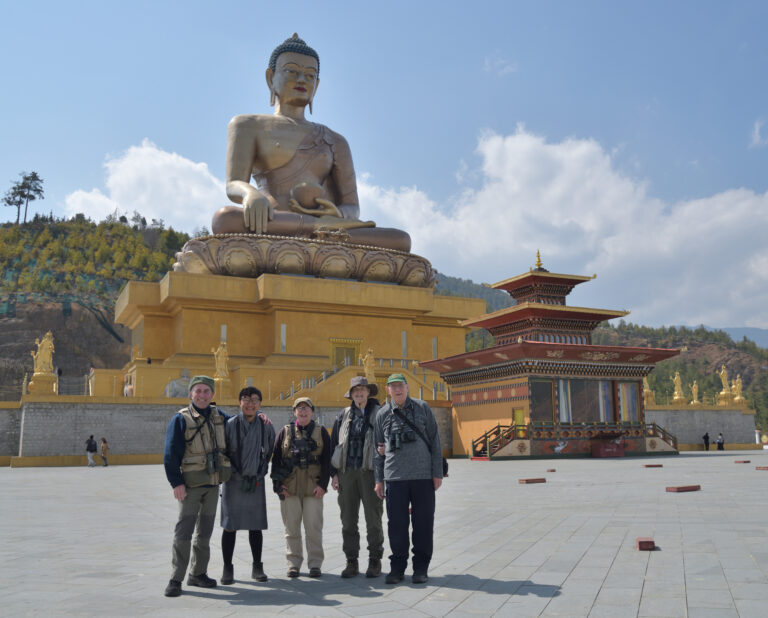
It’s not every day that one starts a tour with a flypast of iconic Mount Everest at sunrise! But here we are on Drukair flight KB203 from Delhi to Paro in the Himalayan kingdom of Bhutan. Once disembarked from the plane, I have never seen passengers standing awestruck on the airport tarmac, as they survey the surrounding scenery. Once inside the terminal building, we arrive in probably the most well decorated airport I have ever seen, with colourful murals of local scenes on all the walls and huge models of ornate palaces within the baggage reclaim conveyor belts! Meanwhile, the smiling immigration officials are equally welcoming with their perfect English, and after a very smooth entry procedure we meet our smiling local guide Tshering.

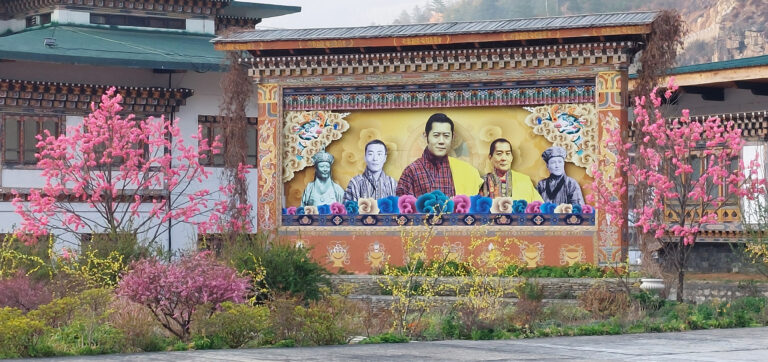
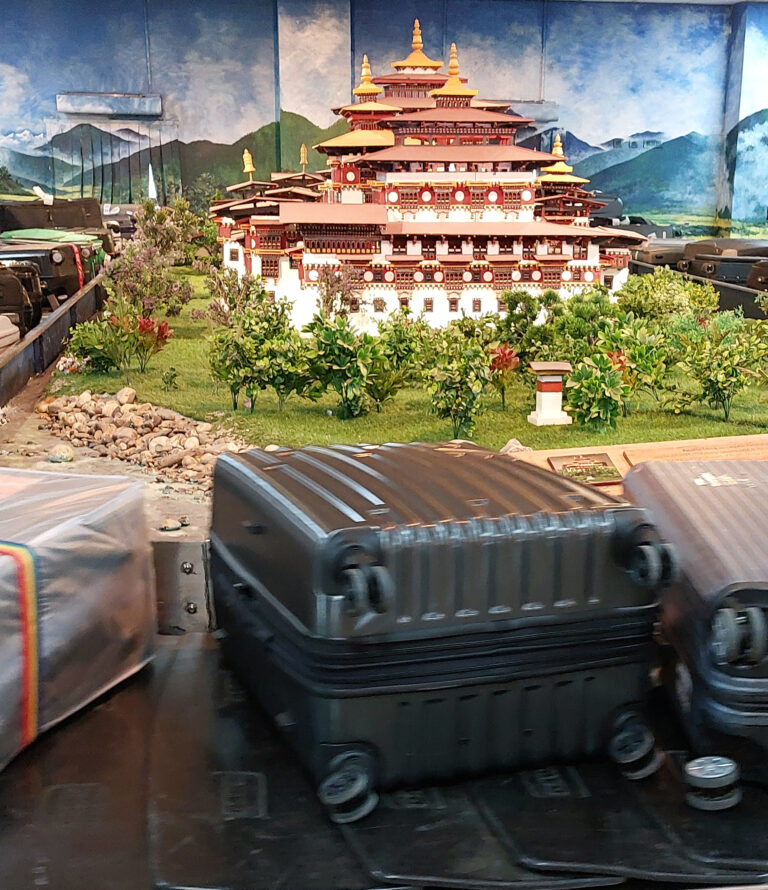
By 7.30am, within an hour of landing, we are strolling along the Pachu River right outside the airport at around 7300 feet above sea level where the first bird on our list is Oriental Turtle Dove, quickly followed by White Wagtail, but not as we know it, as this is the mainly black alboides race. Also along the river is the handsome Russet Sparrow and three different Redstarts; Hodgson’s, White-capped and the male Plumbeous Water Redstart, constantly flicking open its rufous tail as it bobs like a Dipper on the riverside boulders. This being a perfect ‘Dipper river’, we next spot a family of Brown Dippers and then, best of all, three exotic Ibisbills, probing between the pebbles in the clear flowing water with their long red decurved bills.
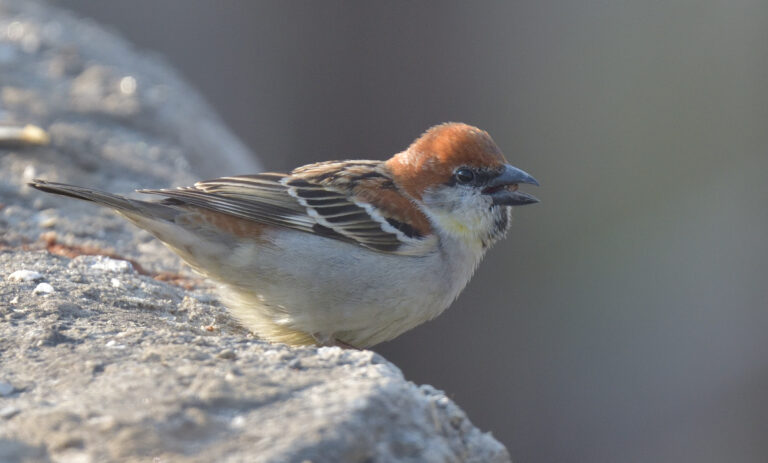
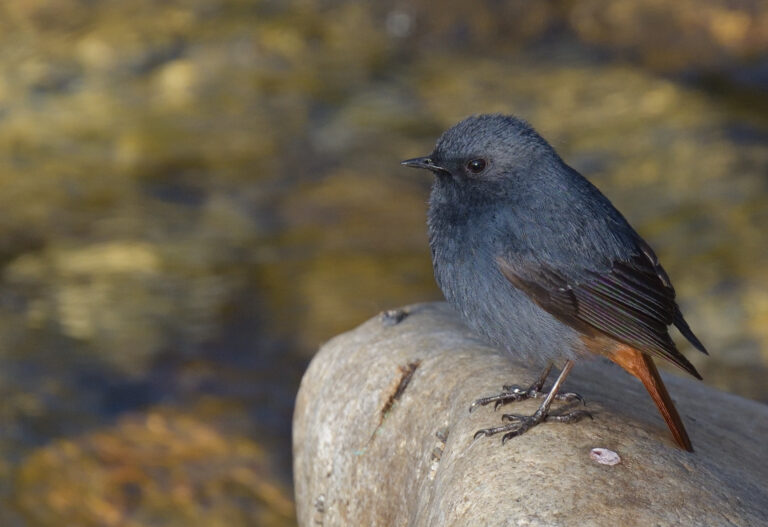
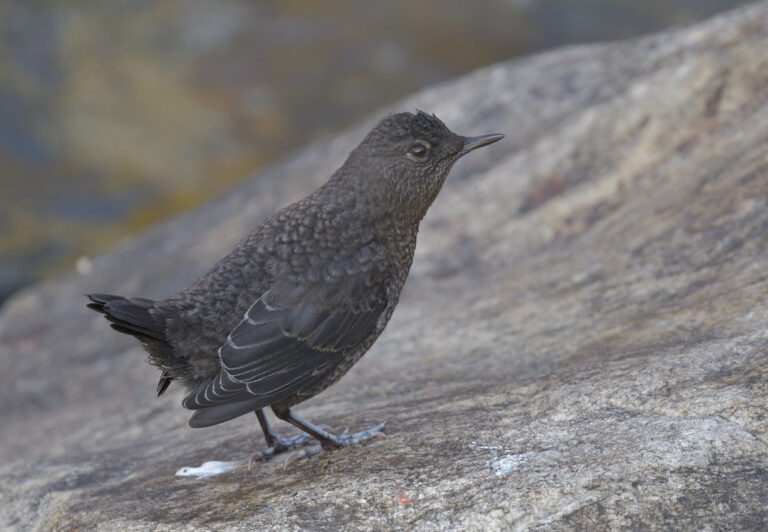
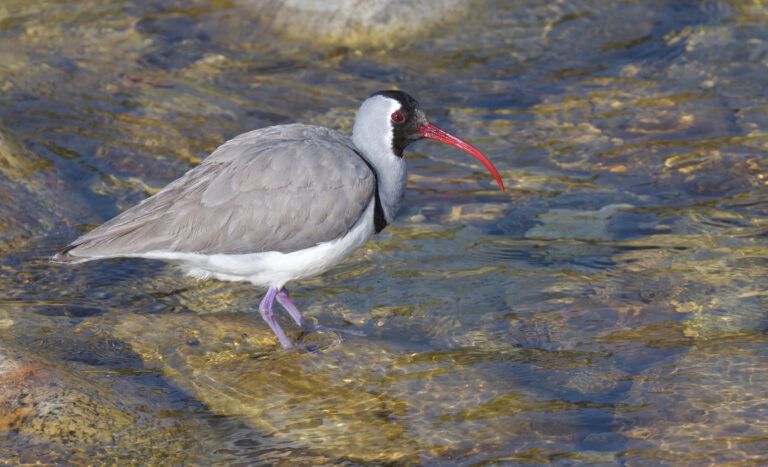
Moving on, we enter a new valley carved by the Wangchu River, spotting a troop of at least forty Grey Langurs along the way, as well as another Brown Dipper and a Blue Whistling Thrush. Further on, an Assamese Macaque peers into the vehicle from just twelve feet away, as if hoping for some handouts.

After checking in to our hotel in Thimphu, the kingdom’s capital, we head to a nearby restaurant for a traditional lunch which is delayed by the appearance of a Himalayan Buzzard hanging on the stiff breeze, along with two Red-billed Choughs and then a Green-backed Tit, singing in the restaurant garden.
This afternoon we begin with a visit to Buddha Point, where an impressive 167 foot high statue of The Buddha sits on a throne at an altitude of about 8700 feet, while a visit to a nearby sewage lagoon produces a flock of 52 Ruddy Shelduck, about ten Little Buntings, three River Lapwings, a couple of Goosanders and a male Siberian Stonechat. So that’s not a bad start to our time in beautiful Bhutan.
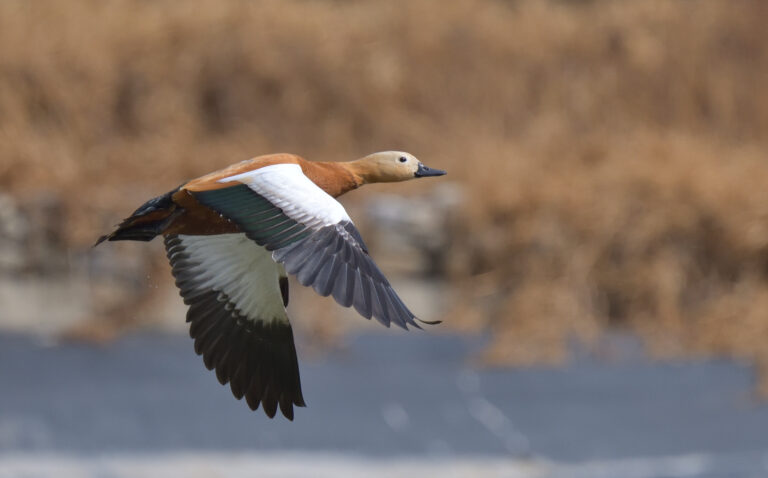
This morning, we are joined by head Guide Norbu as we set off before dawn, with the illuminated Buddha looking down on us from high on the hillside. Hopefully, that’s a good omen as the vehicle winds its way up to the Dochula Pass at an altitude of 10170 feet. It’s light by the time we arrive at the top of the pass to find frost on the ground and a chilly breeze blowing the smoke away from a stove burning incense. First birds of the day are a Large-billed Crow and a roving band of approachable Yellow-billed Blue Magpies, and as the morning slowly warms a variety of small birds appear from the high coniferous forest including White-browed Fulvetta, Yellow-browed and Grey-crested Tits, and the aemodius race of Coal Tit with an unusual spikey crest, plus Hodgson’s and Blue-fronted Redstarts. Exploring the woods at the back of a restaurant, home to Russet Sparrows, we find a pile of food waste attracting a steady stream of visitors at very close range such as Black-faced Laughingthrush, Himalayan Bluetail, Dark-rumped Rosefinch, more Yellow-billed Blue Magpies and an impressive Blue Whistling Thrush. By now it’s 8am and time for a well-earned breakfast, starting with porridge, and a chance to warm up beside a wood-burning stove.
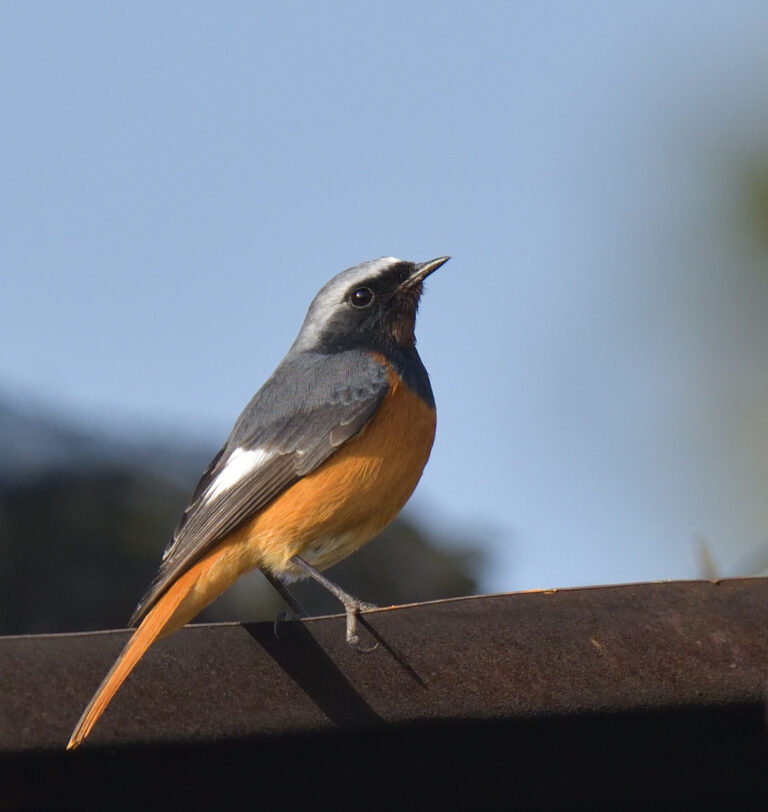
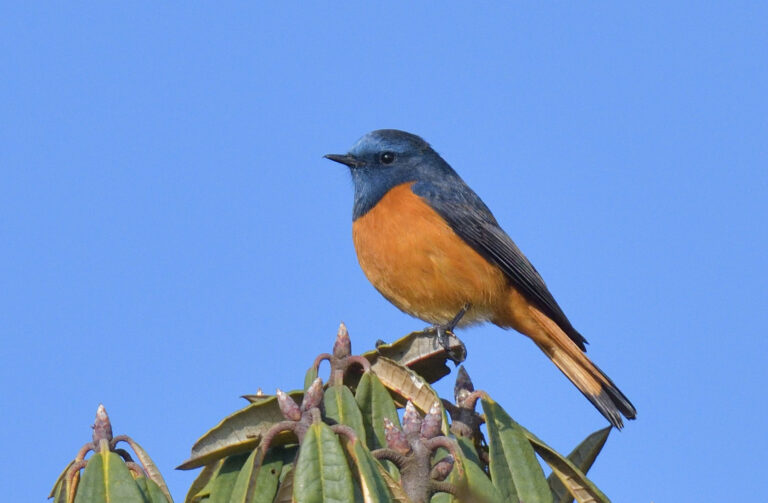
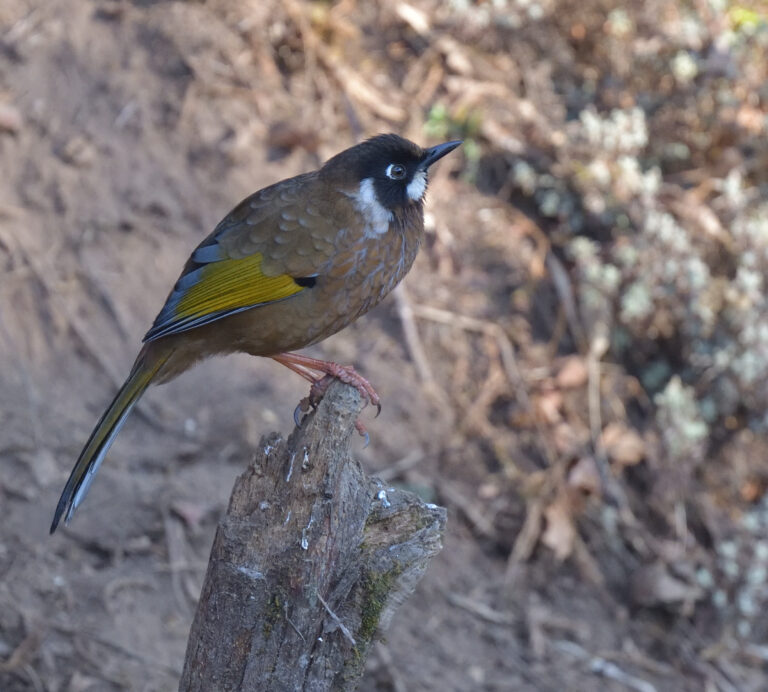
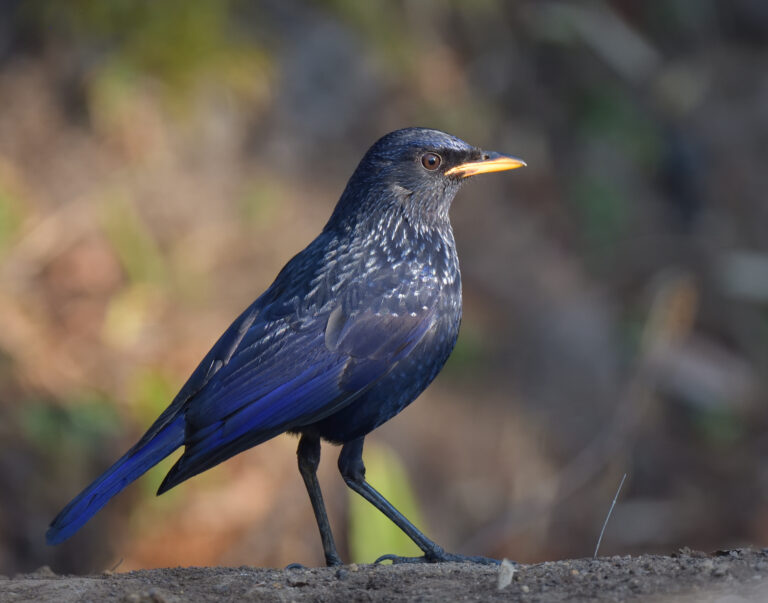
From here, we drive down to the nearby Lampelri Botanical Park, carpeted with delicate lilac blooms of Primula denticulata, where the towering trees are home to birds like White-tailed Nuthatch, Rufous Sibia, Hoary-throated Barwing, Darjeeling Woodpecker, Striated Laughingthrush, Green-tailed Sunbird, singing Ashy-throated Warblers, and Rufous-capped Babblers which skulk in the undergrowth.
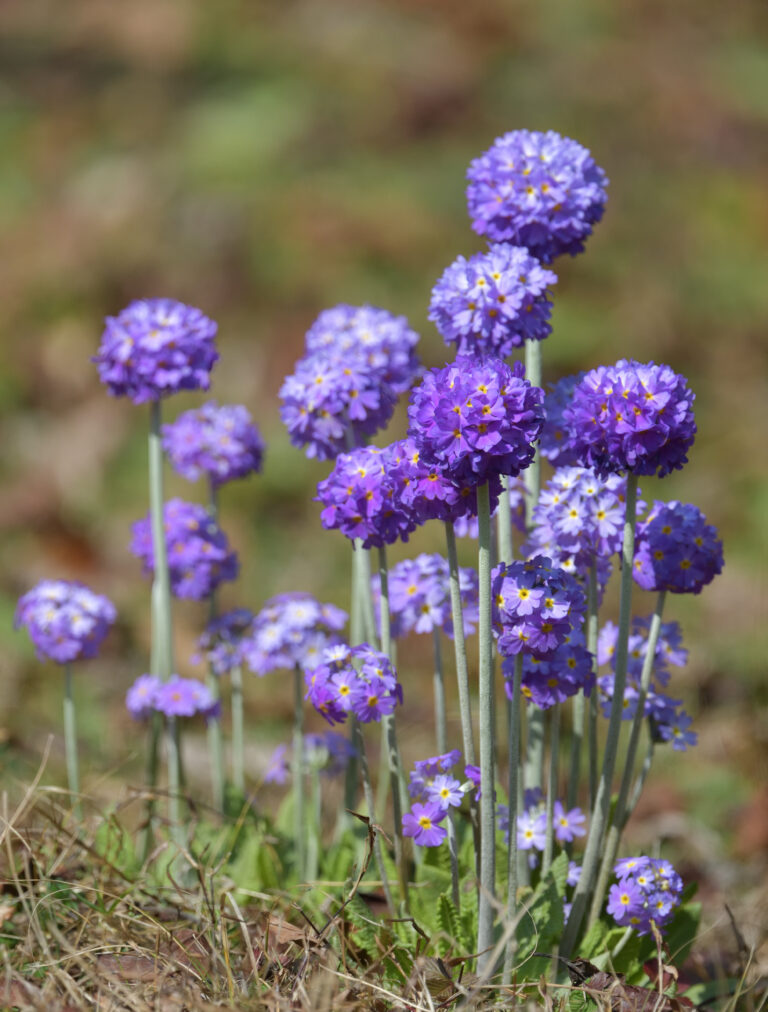
After a short drive further downhill, we pull in to a layby hoping for Ward’s Trogon and soon find a calling male perched just above the roadside. Lower still, another roadside stop below a high cliff with several large colonies of bees clinging to the rockface produces our target Yellow-rumped Honeyguide. Beside all the bees, the forest here is a hive of activity for small birds like Grey-hooded Warbler, Nepal Fulvetta, White-capped Redstart, Spot-winged Grosbeak, a tiny Speckled Piculet and an equally tiny skulking Scaley-breasted Wren Babbler which shows well for a couple of seconds!
By now, it’s mid-afternoon and time to move on to the impressive seventeenth century Palace of Great Bliss at the confluence of the Father (Pho Chu) and Mother (Mo Chu) Rivers. Along the Mother River, we spot Ruddy Shelduck and the huge Crested Kingfisher, while other birds inside the ornately decorated monastic courtyards include Kestrel, Common Myna, Black Bulbul and Indian White-eye.
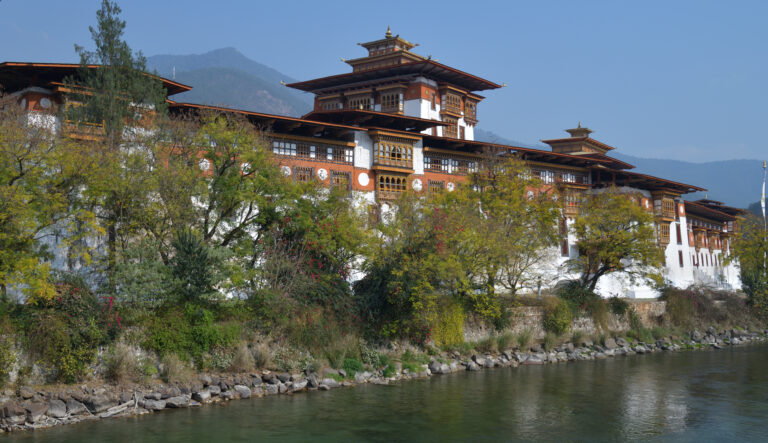
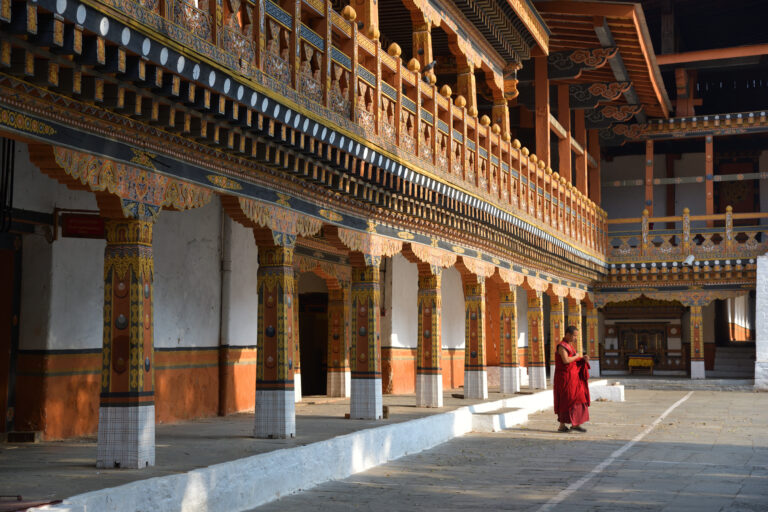
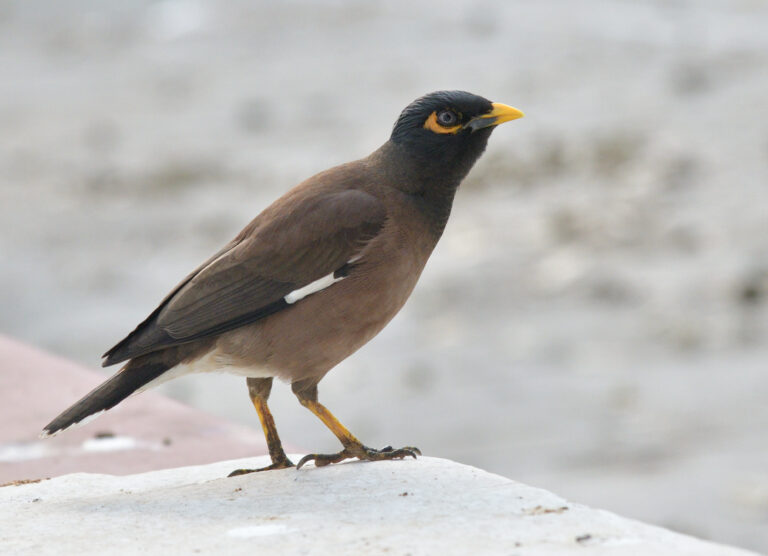
This morning we set off at 6am on a drive up the valley carved by the Mother River, arriving in a lightly cultivated area in time to see the sun rise over the forested ridge, bringing to life a nice selection of birds like Verditer Flycatcher, Red-vented and Black Bulbuls, Lemon-rumped and Grey-hooded Warblers, Green-backed Tit and a pair of Scarlet Minivets, plus Ashy Drongo, Grey Treepie and Oriental Magpie Robin all on the same wire. Further up this beautiful wooded valley we enter Jigme Dorji National Park and soon find a male Fire-breasted Flowerpecker, a crested White-bellied Erpornis and a lively pair of Black-throated Bushtits at very close range, followed by Grey-chinned Minivet and Greater Yellownape, with an amazing flamboyant coiffure, and certainly one of the most stunning woodpeckers I have ever seen. By now we are in a steep sided valley with towering forested slopes which reach up to the clouds! Along the cascading tree-lined river we scope a Pallas’s Fish Eagle, watching the river below from its treetop perch and by 9.15am as the morning warms up, we also scope a perched Crested Serpent Eagle. Further up the narrow winding road we find a mixed flock of small birds moving so fast it’s hard to keep up with the sightings which include Rufous-winged and Nepal Fulvettas, Rufous-capped and Golden Babblers and Grey-headed Canary Flycatcher. Moving on again, at the next stop, we enjoy incredibly close views of a singing Chestnut-crowned Warbler and then bump into a Slaty-backed Forktail at the side of the road! Around noon, a final stop before lunch produces amazing views of another Greater Yellownape, a couple of Mountain Bulbuls and a large flock of White-throated Laughingthrushes, quietly turning over the dry leaf litter.
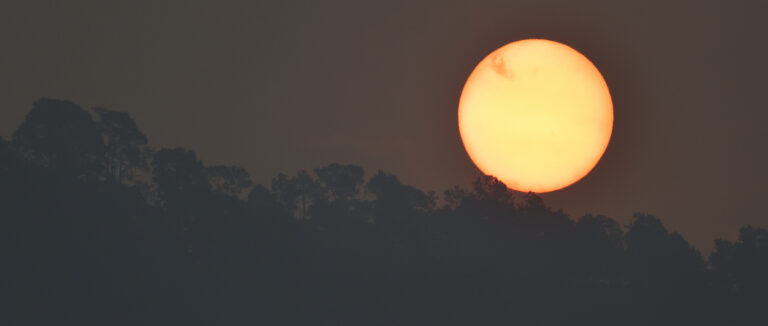
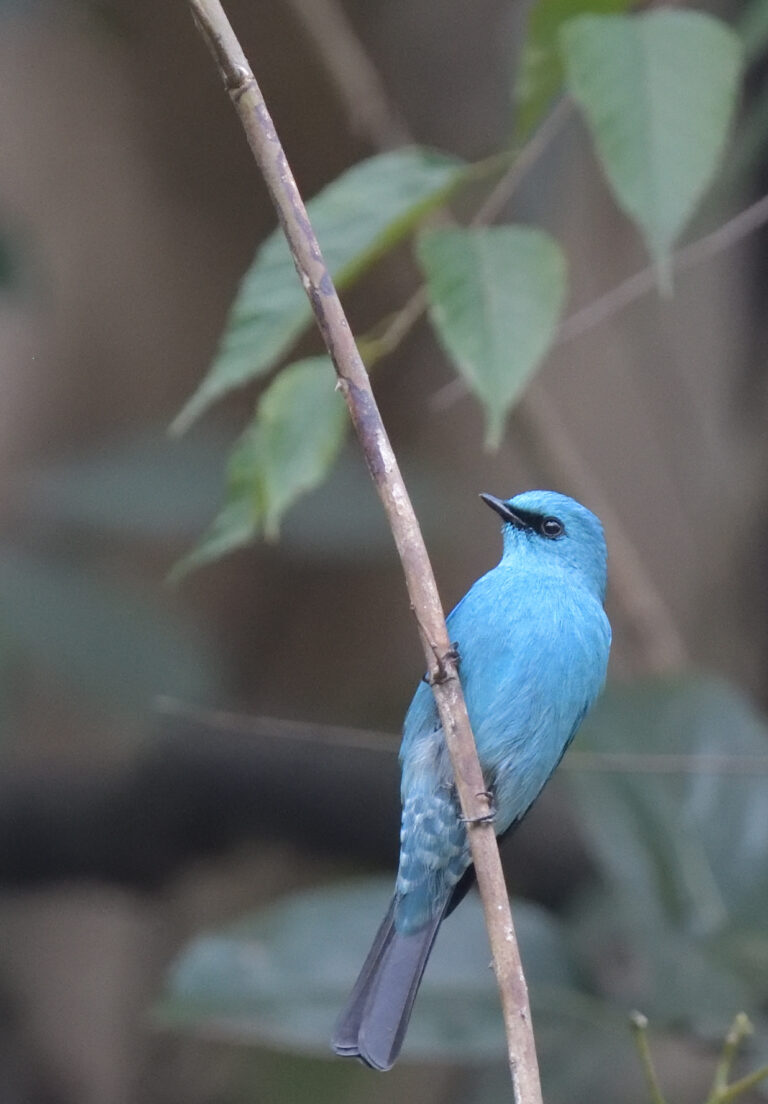
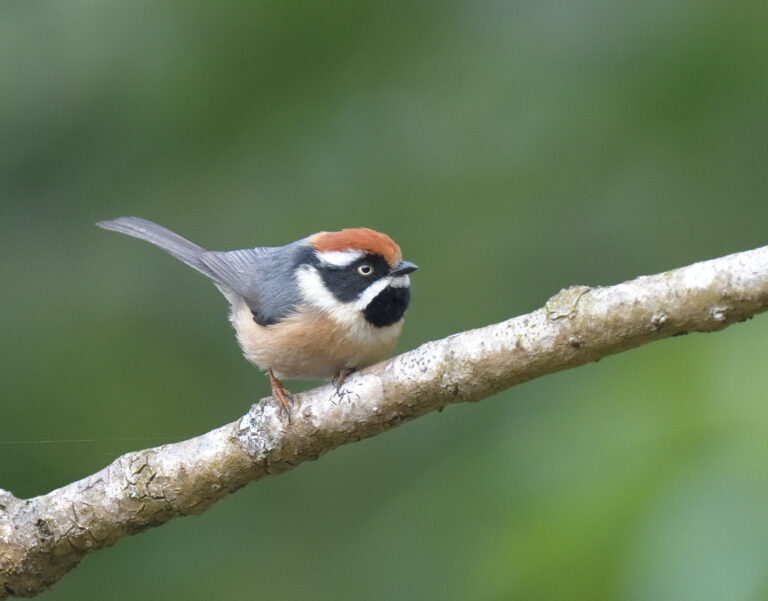
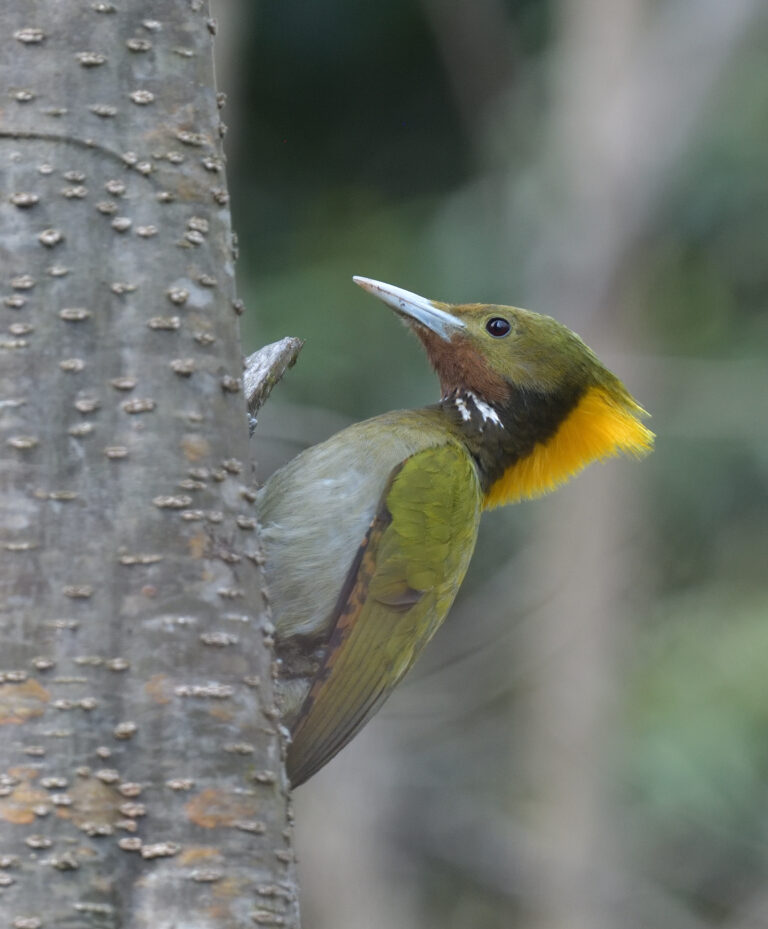
After a lovely picnic lunch in the sunshine, we add a vociferous but shy Bay Woodpecker to the growing list, and on the way back down the valley, we spot a male Black-throated Sunbird, and then a flock of about ten Kalij Pheasants cross the road ahead and disappear into the forest. At the next stop, on a bridge below a huge cascade, we find a Little Forktail gleaning insects from the wet rocks and then further on, a group of Whiskered Yuhinas are also new for the list, followed by a Spotted Forktail, turning over wet leaves beside the road, making three different forktails today! Last new bird of the day, bringing the tally to 44 is a Great Barbet, and at the last stop we eventually find another reclusive Bay Woodpecker.
This morning, we leave Punakha and its lovely view of the monastery in the valley below and head south along the Punatshang River, where the first riverside stop produces River Lapwing, Crested Kingfisher and one Bar-headed Goose amongst a flock of around 300 Ruddy Shelduck, as well as Spotted Dove, Long-tailed Shrike and three Hoopoes. Moving on, our guide hears the shrill whistles of Green Magpies which blend in very well with the foliage, but once found, their neon green bodies and powder blue heads really stand out, enhanced by coral red bills, legs and eye rings, with black face masks. On any day these would be a strong contender for ‘bird of the day’. On our next roadside stroll, we soon find Scarlet Minivets and a very vociferous Chestnut-bellied Nuthatch calling from the end of a dead branch, followed by a pair of Slaty-backed Forktails feeding by a small cascade, plus a Mountain Hawk Eagle circling overhead, a Grey-capped Pygmy Woodpecker and finally a group of tiny, active Black-chinned Yuhinas at very close range.
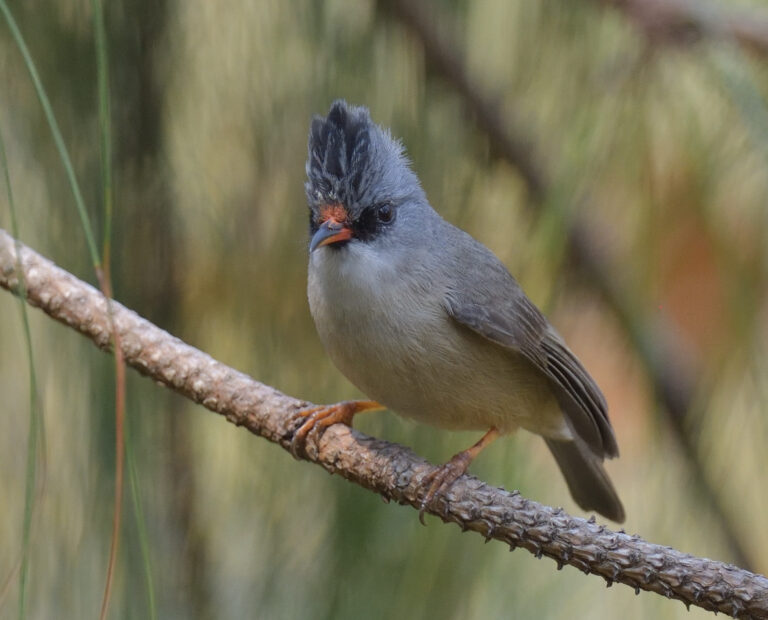
By late morning, we arrive at a viewpoint overlooking the fast flowing clear blue river, where one of the main targets of the entire trip can be found, with a lot of luck. Pointing the scope way downstream, there it is standing on a boulder in mid stream in a statuesque pose with a long sinuous neck and an enormous dagger of a bill pointing down at the water. “I’ve got the heron!” I exclaim. Incredibly, we have found one of the world’s rarest birds, with a global population of around sixty birds, including just 27 in the whole of Bhutan! Standing just over four feet tall, with a wingspan of over six feet, this is the world’s second largest heron, and losing this magnificent bird would be a terrible tragedy, which is just too awful to contemplate. After a picnic lunch at this wonderful viewpoint, we drive a short way downstream hoping for a closer view of the heron and lo and behold, we find the local pair in the same scope view, standing on different boulders in the strong current and close enough to see their white nape plumes blowing in the breeze! Wow, what a result!
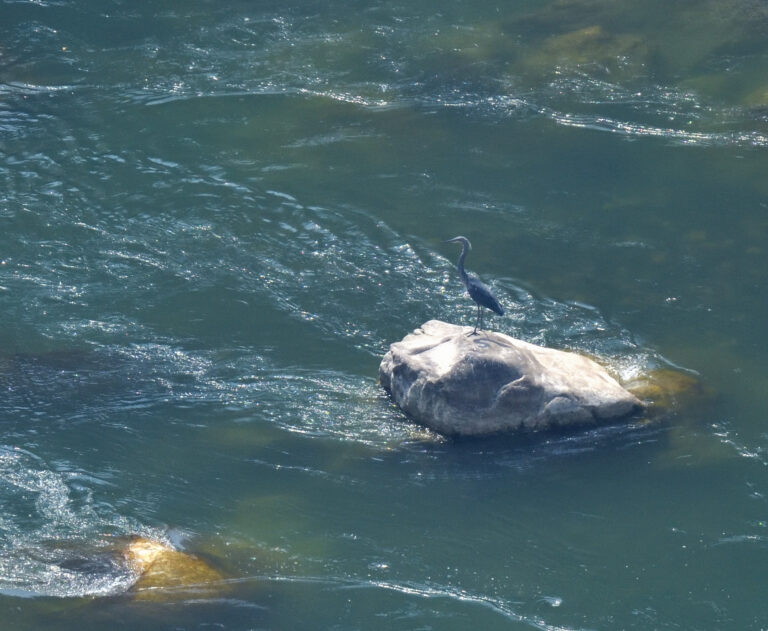
Moving on again, we leave the river valley and take a short roadside stroll, with Chestnut-headed Bee-eaters overhead. The forest here is very productive and notable sightings include Chestnut-bellied Nuthatch, Yellow-bellied and Blyth’s Leaf Warblers, Blue-throated Barbet, White-throated Bulbul, a very smartly marked Black-eared Shrike Babbler, a male Grey-chinned Minivet with a harem of about thirty females and a Malayan Giant Squirrel.
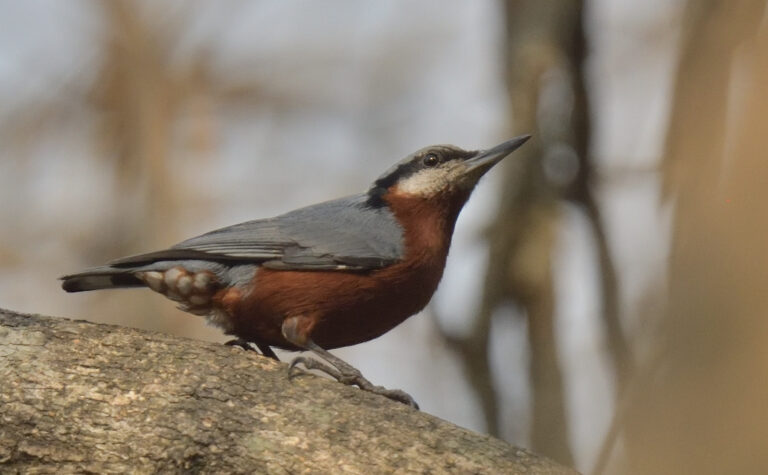
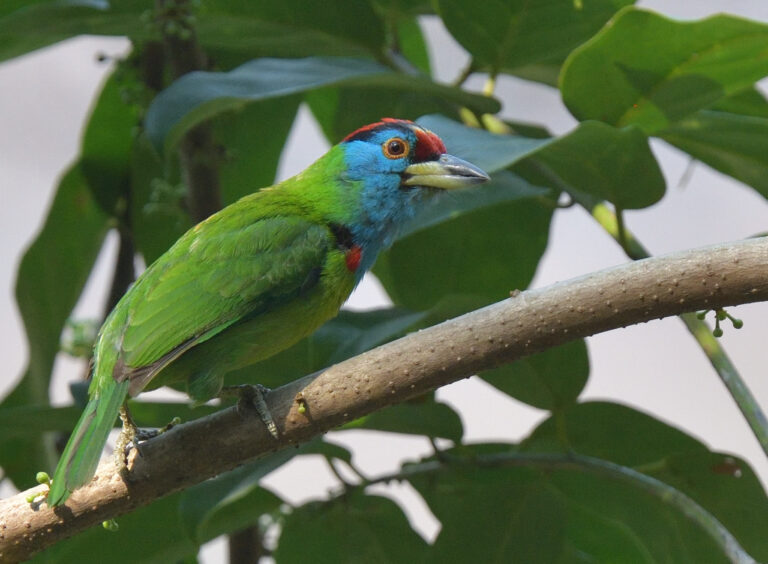
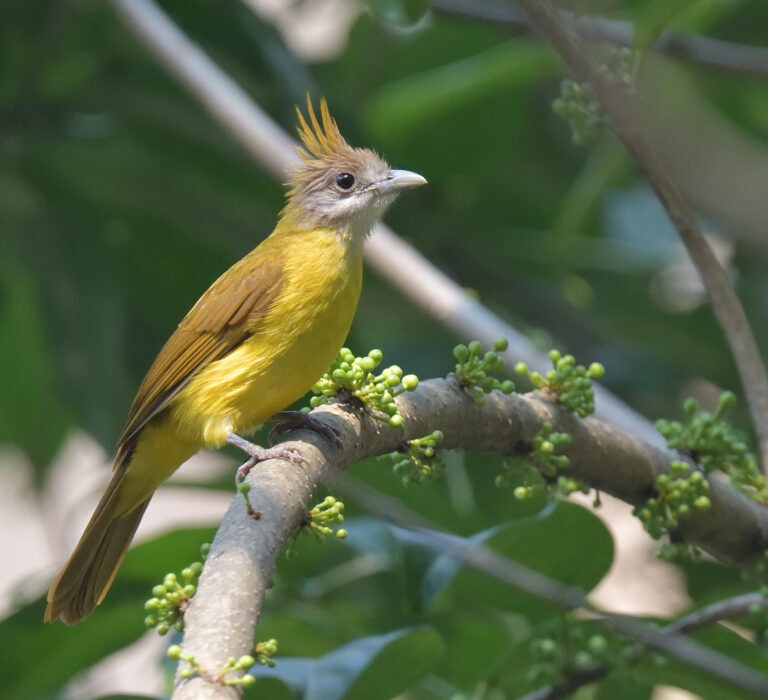
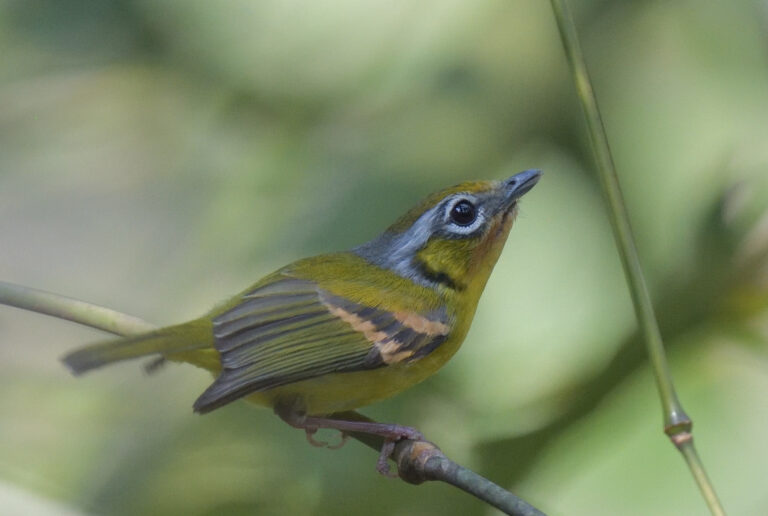
Further on, another stroll beside a small cascade produces both Spotted and Slaty-backed Forktails, while a troop of well over sixty Assamese Macaques scamper across the road. Amongst the trees here we also find Yellow-vented Warbler, Grey-throated Babbler, a vivid blue Small Niltava, exquisite White-crested Laughingthrushes feeding in bright red blossoms and a Lesser Yellownape woodpecker with an extravagant red and yellow punk ‘hairstyle’. Journey’s end is Tsirang at an altitude of 4700 feet.
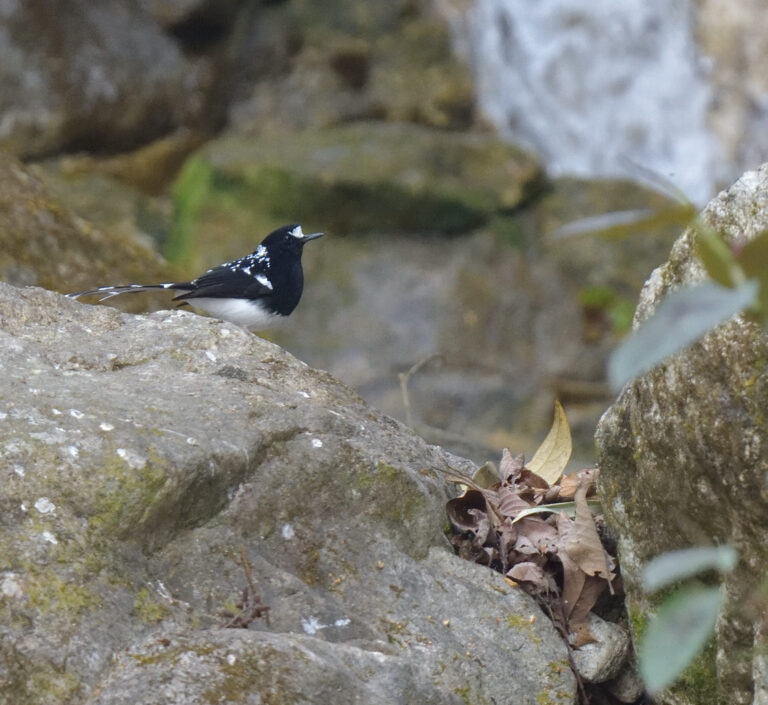
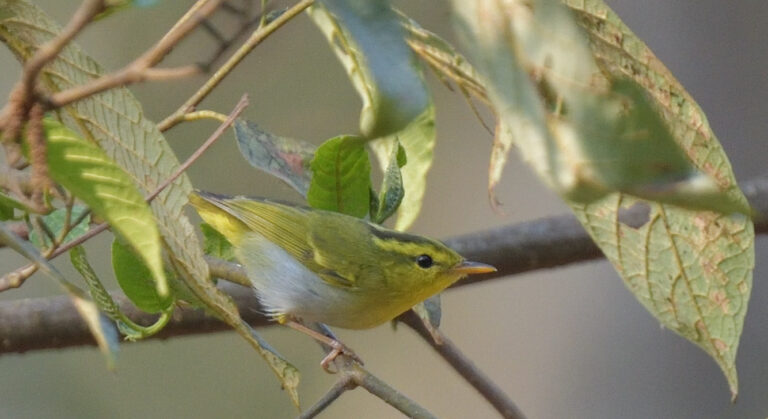
It’s a bit nippy first thing this morning as we drive off to explore a stretch of road heading south from Tsirang to Darachu through a fabulous forest of unfamiliar evergreen broadleaved trees with numerous mossy branches. Early birds along the road include a Rufous-bellied Eagle perched in a bare tree, two Slaty-backed Forktails at a cascade by a small shrine and a flock of smart Chestnut-crowned Laughingthrushes feeding right beside the road. By 7.30am we begin to explore a downhill stretch of narrow road through the forest on foot, where our first new bird for the trip list is a group of yellow-rumped, female Scarlet Finches showing well while feeding in nearby trees, while a Mountain Imperial Pigeon pumps its chest to emit a deep resonant double boom. In fact, the trees are filled with a cacophony of birdsong as well as the harsh scolds of a roving band of very exotic Coral-billed Scimitar Babblers which pass by en masse, pillaging mossy branches with their curved red bills as they go, while another contender for bird of the day is a very showy male Black-eared Shrike Babbler. The good sightings continue with Crimson-naped Woodpecker, Rusty-fronted Barwing and a Mountain Tailorbird, so mobile in the foliage that it’s a real jigsaw to piece together. It’s now 9.30am and time for a tea break.
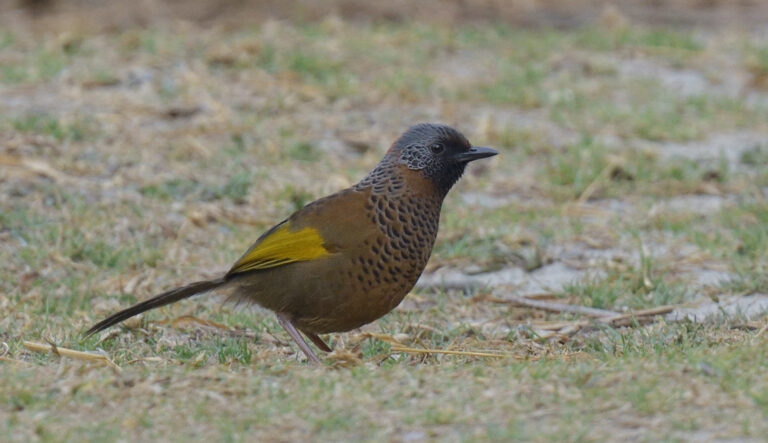
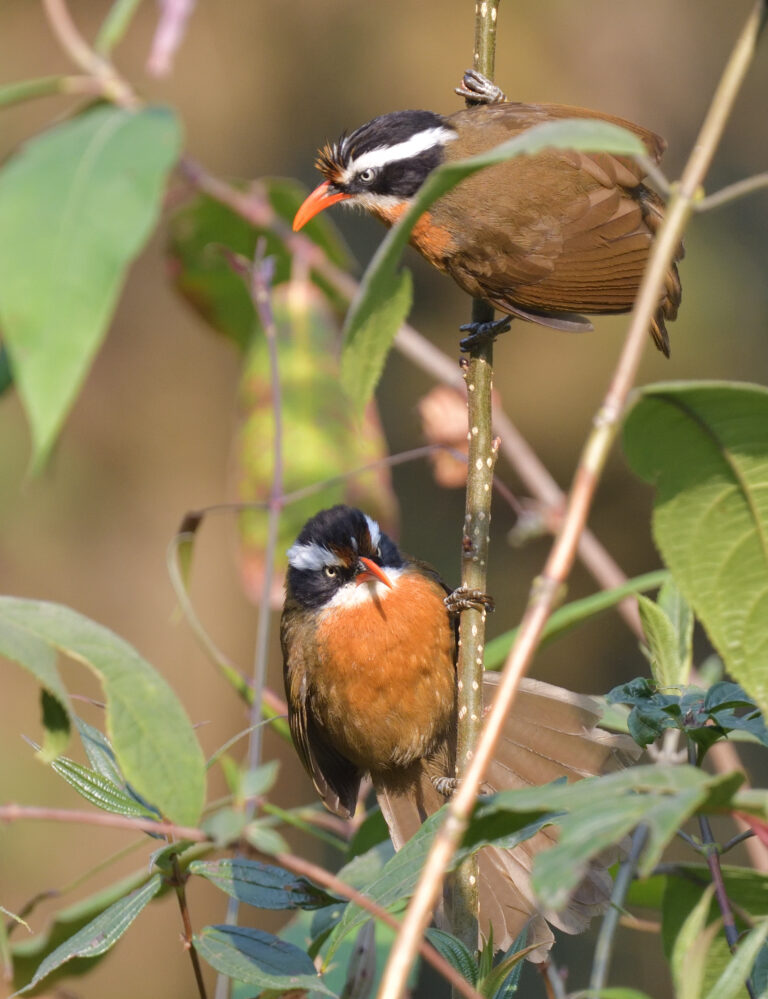
We restart with a male Chestnut-bellied Rock Thrush posing in a tree top, followed by more new birds like Yellow-throated Fulvetta, Bar-throated Minla, Golden Babbler, Rufous-gorgetted Flycatcher, Grey-sided Bush Warbler, which is a Cetti’s Warbler lookalike, and finally, after a lot of peering into the undergrowth, a super-skulking Grey-bellied Tesia, for some. Next, Tshering mimics the call of a Collared Owlet which soon creates an absolute frenzy in an adjacent tree as a mesmerising congregation of small birds gathers to scold the owlet. During the rumpus we spot Green-tailed and Black-throated Sunbirds, Fire-breasted Flowerpecker, White-tailed Nuthatch, Black-faced Warbler, White-naped Yuhina, Green-backed and Yellow-cheeked Tits and Little Pied Flycatcher. The action subsides just as the shadow of a low-flying Black Eagle passes across the road. We end a very productive morning with Grey-cheeked Warbler and then two ‘Ninja skulkers’ within twenty minutes; Scaley-breasted and Rufous-throated Wren Babblers!
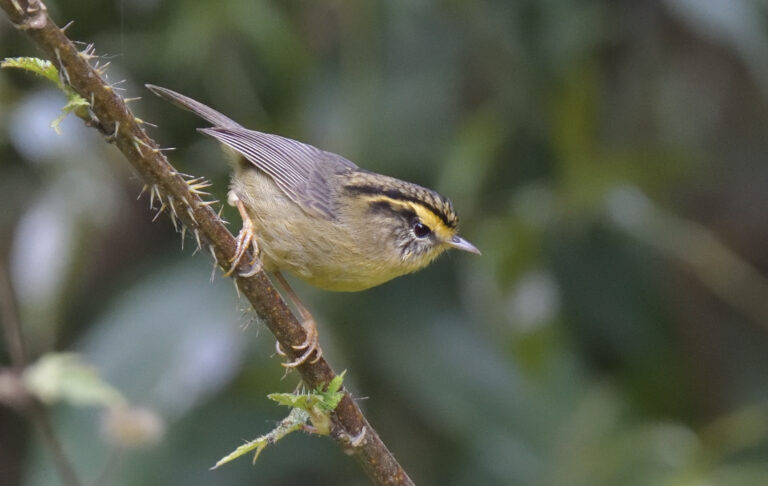
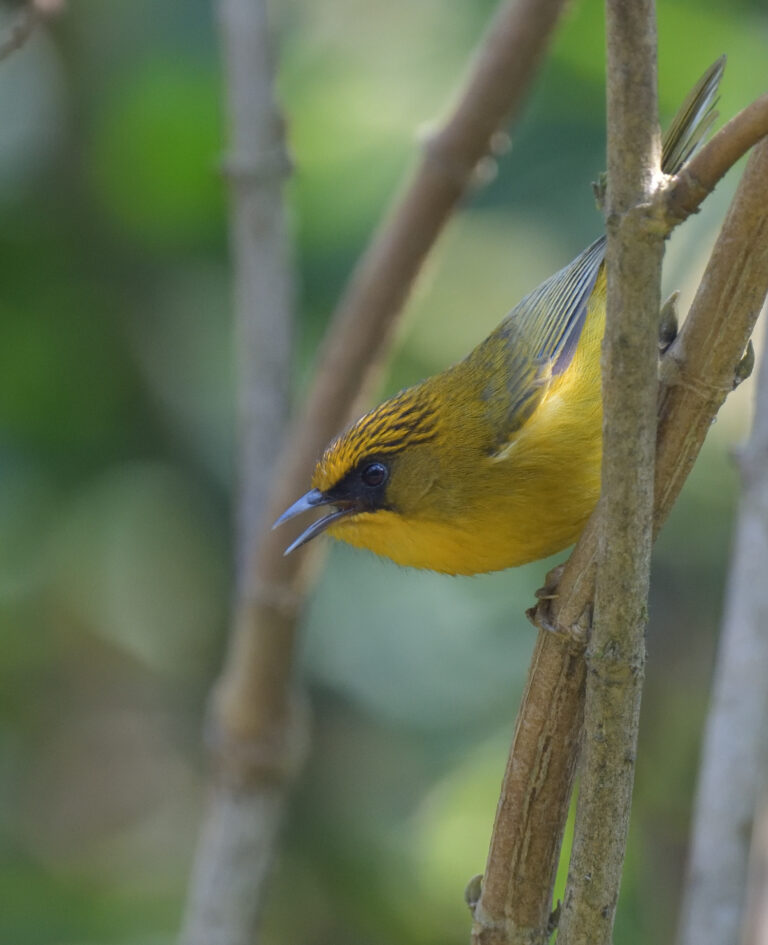
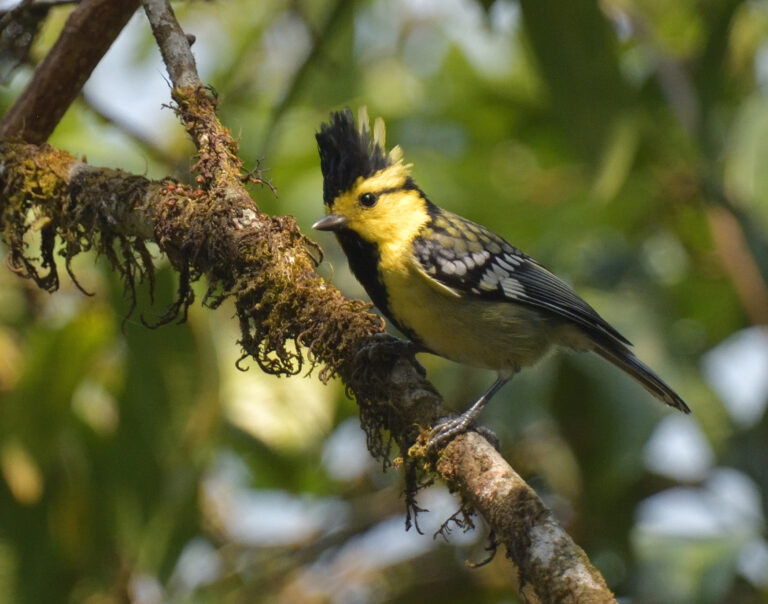
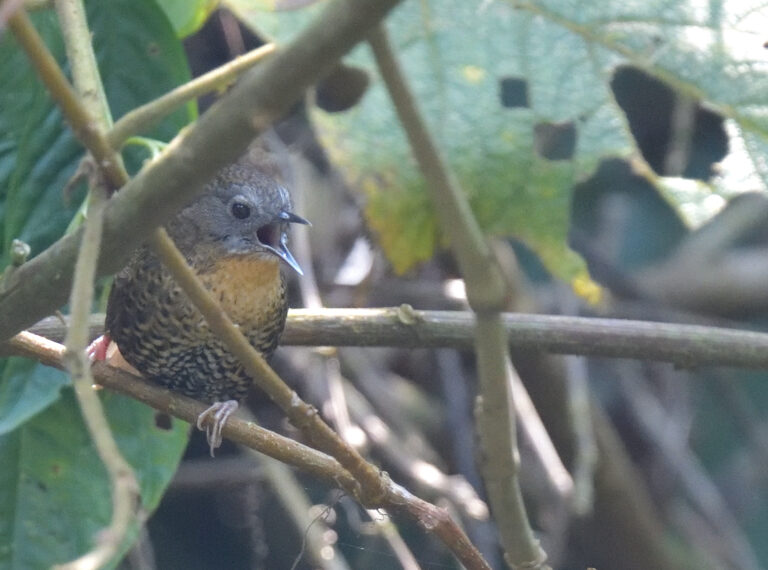
After a delicious picnic lunch with table and chairs in the sunshine, we descend to Sarpang where the Himalayan foothills meet the Indian plain, just 725 feet above sea level. Passing within sight of the Indian border just a few yards away, a plethora of exotic new sightings come thick and fast in this new habitat including Indochinese Roller, Blue-bearded Bee-eater, Red-breasted Parakeet, Pin-tailed Green Pigeon, Greater Racket-tailed Drongo and Green-billed Malkoha, while Chestnut-tailed and Asian Pied Starlings, crested Great Mynas, Jungle Babblers and a Black-hooded Oriole all feed on nectar from flame-red tree blossoms. We scope a Lineated Barbet in a tree a few yards south of the Indian border and then an impressive male Wreathed Hornbill flies by to land across the border. Moving on to our base in the border town of Gelephu, passing triangular road signs depicting an Elephant, we spot more new birds like Cattle Egret, White-throated Kingfisher, Pied Bushchat, Red-whiskered Bulbul and a displaying Peacock. With a tally of 74 birds seen today, picking the ‘bird of the day’ after the evening bird log is a real challenge.
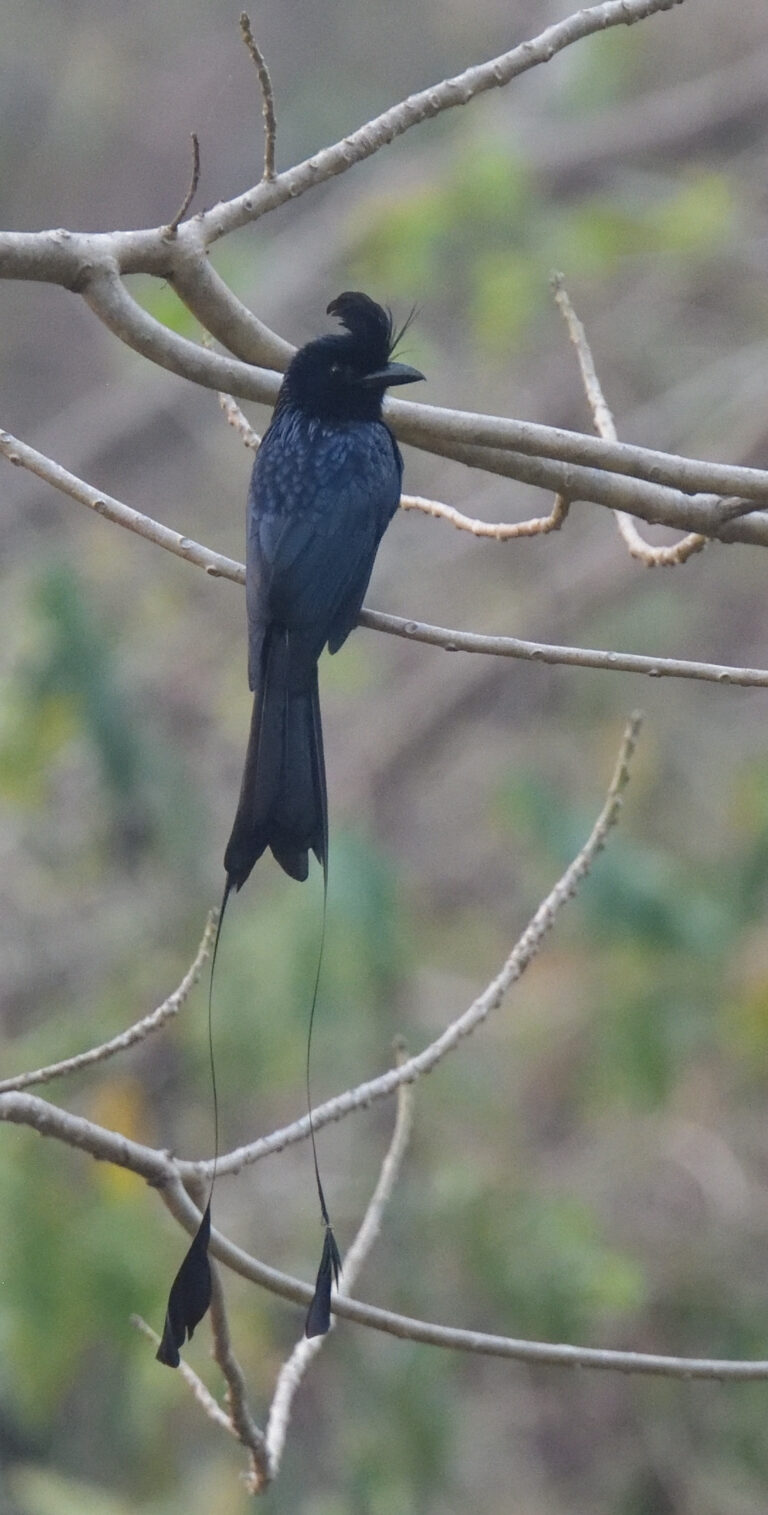
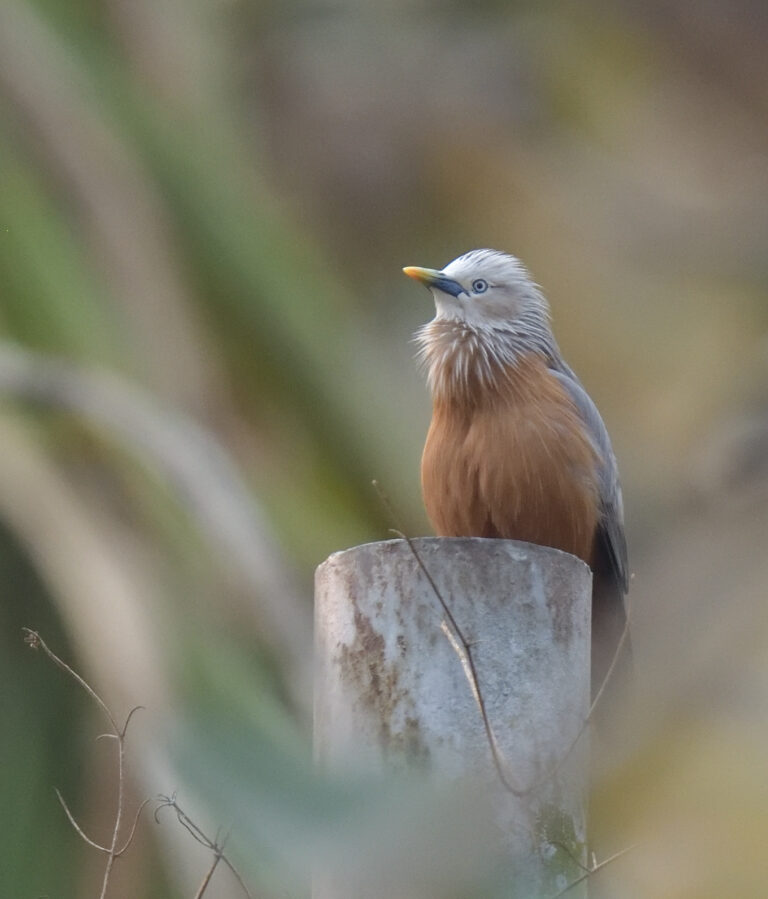
There’s a big red sun outside the hotel this morning where a brief birding spell produces sightings of Green Imperial Pigeon, Red-breasted Parakeet, Lineated Barbet, Oriental Magpie Robin, Rufous-necked Laughingthrush, Jungle Babbler, Red-rumped Swallow, Common Iora and the local rufiventris race of Black Redstart, while a pair of Wreathed Hornbills fly over with audible wingbeats like those of a swan.
Next, we explore the wider open wooded area to find new birds like Large Cuckooshrike, Grey Bushchat, Long-tailed Sibia, Black-naped Monarch, Black-crested Bulbul, Crimson Sunbird, Lesser Necklaced Laughingthrush, Pale Blue and Blue-throated Blue Flycatchers, a circling Oriental Honey Buzzard and the iridescent navy blue Hair-crested Drongo. Meanwhile, one particular flowering Silver Cotton Tree attracts a variety of birds like Red-vented Bulbul, handsome Orange-bellied and Golden-fronted Leafbirds, and the lively Streaked Spiderhunter with a bill like a Curlew Sandpiper.
After lunch back at the hotel, we visit the local ‘poo plant’ and get in via a ‘cat flap’, while ignoring the “Do not enter” sign! Inside the gate, several ‘ponds’ produce a variety of waterbirds like Lesser Whistling Duck, Little Cormorant, Indian Pond Heron, Grey-headed and Red-wattled Lapwings, Common, Green and Wood Sandpipers, loads of Greenshanks and a White-throated Kingfisher, as well as Grey, White and Citrine Wagtails. Asian Palm Swifts whizz by overhead, while the surrounding scrub produces Alexandrine Parakeet, Asian Koel, Rufous Treepie, Aberrant Bush Warbler (I am not making these names up), a Red Junglefowl cockerel and a yellow-eyed Asian Barred Owlet, vibrating its whole body as it calls. On the way back to the hotel, we have to stop for an Asian Pied Hornbill, tossing back figs into its large casqued bill, and after a nice cup of tea in the hotel, a quick owling session in the immediate neighbourhood produces a pair of Brown Hawk Owls as well as some medium sized bats hawking around the houses.
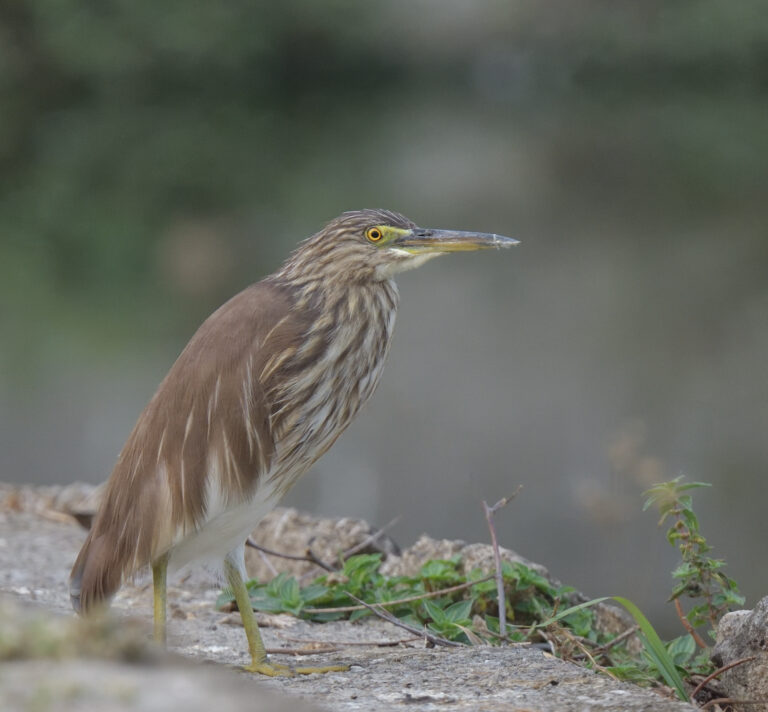
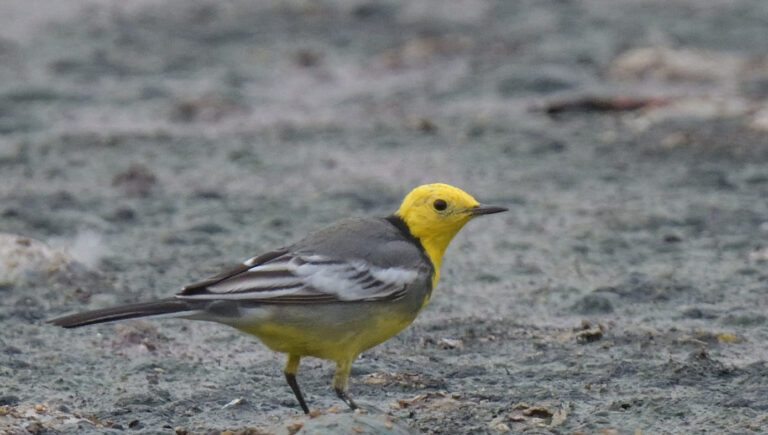
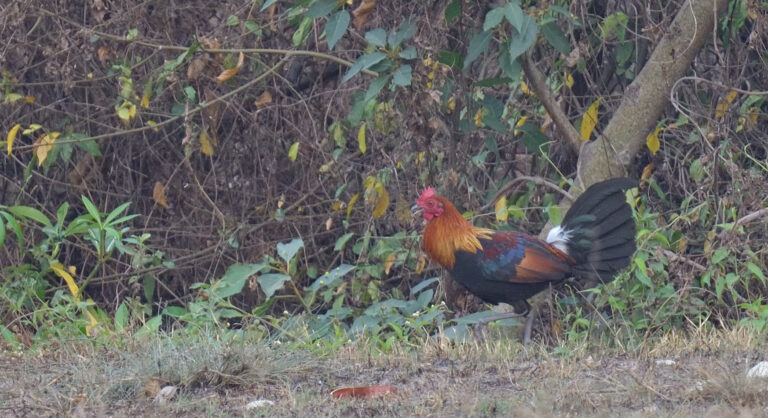
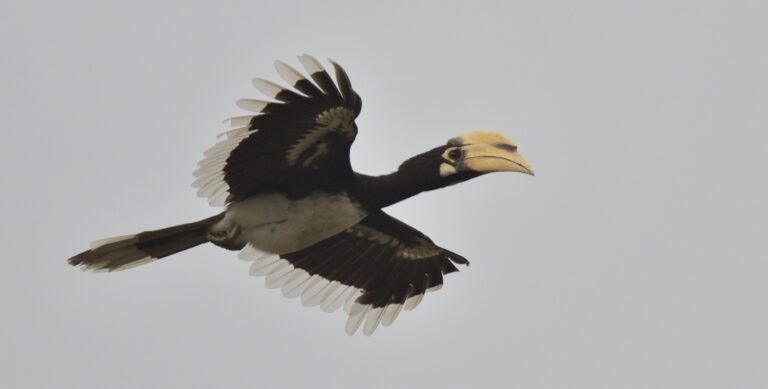
Coppersmith Barbet and Jungle Myna are new birds outside the hotel first thing this morning as we head off on a 58 mile journey which always takes at least three hours due to the bumpy winding roads! Not far out of town, we stop for a cock Red Junglefowl, followed by other birds like Lesser Yellownape, Black-hooded Oriole, Hair-crested and Greater Racket-tailed Drongos, and Common Hill Mynas with bright yellow head wattles. From here, it’s onward and upward on the convoluted PNH-5 road which winds its way up to Tingtibi, through pristine broadleaved evergreen forest, with numerous Blue Whistling Thrushes posing at the roadside along the way. The first stop produces sightings like Black-crested Bulbul, Puff-throated Babbler and a flock of at least 100 multi-coloured Silver-eared Mesias. Next, we stop to scope a majestic Crested Serpent Eagle standing on a bare branch, and on a short stroll, we find another of the main target birds of this area, a pair of awesome Rufous-necked Hornbills, showing really well in a nearby bare tree. Only the male has a rufous head and neck, but both birds have bright blue orbital skin, red throat pouches and impressive ivory bills. Wow!
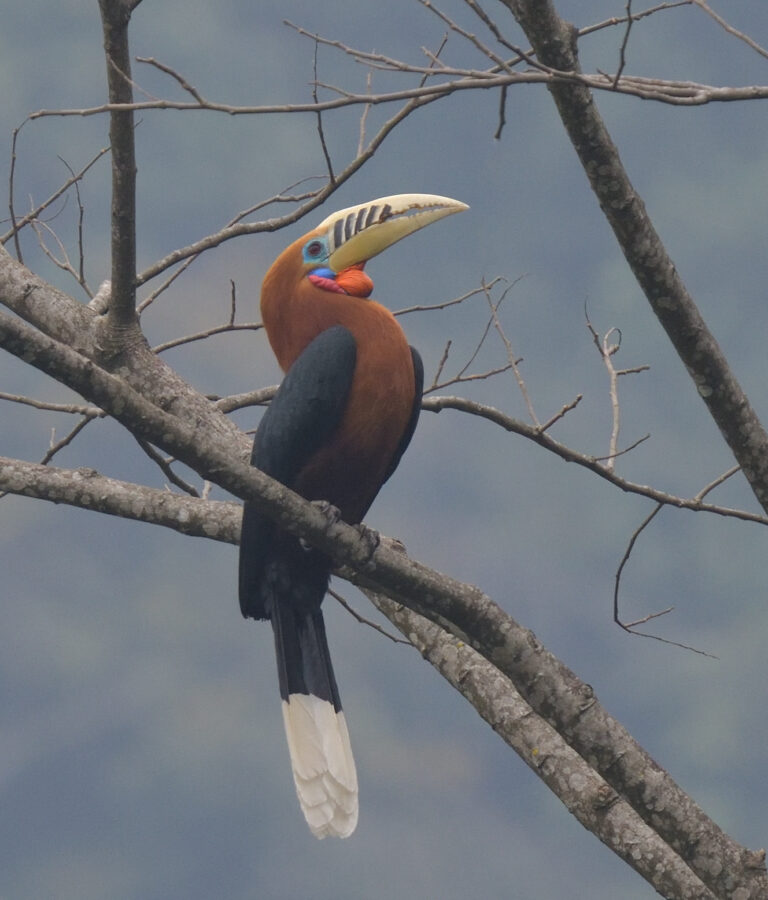
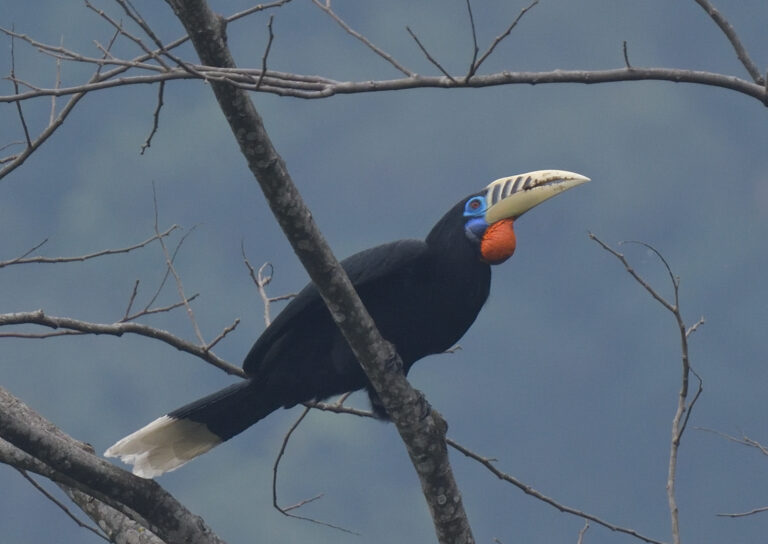
By now we are at about 3000 feet above sea level and finding other birds like Small Niltava, White-spectacled and Hume’s Leaf Warblers, Ashy Bulbul, Sapphire Flycatcher, Lesser Racket-tailed Drongo, Chestnut-bellied Rock Thrush, Grey-chinned and Short-billed Minivets and the striking Red-faced Liocichla, which on any other day would probably be ‘bird of the day’ were it not for those hornbills.
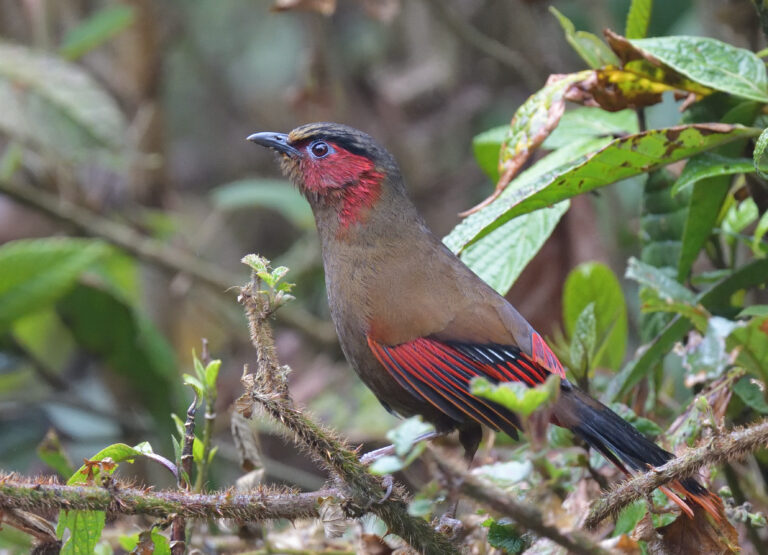
Given the light drizzle, we have our picnic lunch in the shelter of a small temple at the Tamala Pass which is today’s highest point at about 7000 feet. After lunch, the leftovers are polished off by a couple of Large-billed Crows, while other birds here include Rufous-winged Fulvetta, Blue-fronted Redstart, Himalayan Bluetail, Grey Bushchat, loads of Green-backed Tits, a roving flock of White-throated Laughingthrushes and last but not least, a lovely little Pygmy Blue Flycatcher. Journey’s end is Tingtibi, a ‘one horse town’ at around 1970 feet, where the eccentric Twang Hotel doubles as a bar and grocery-cum-hardware store, rather like the old-fashioned pubs in Ireland.
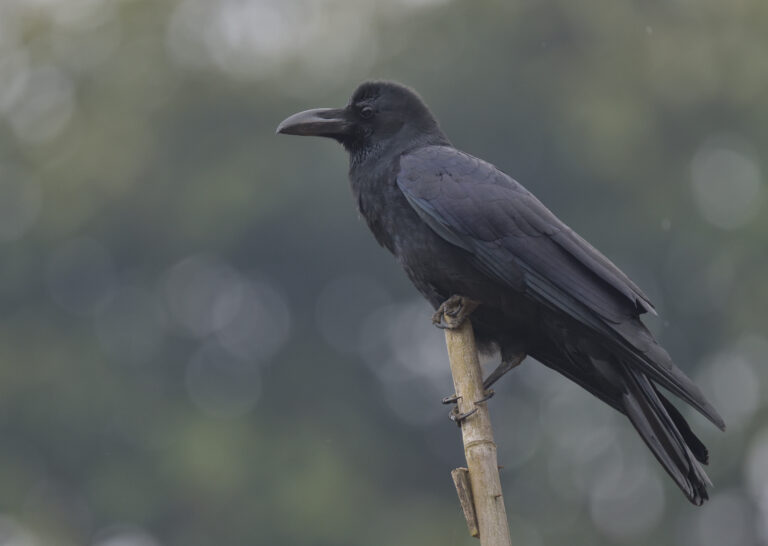
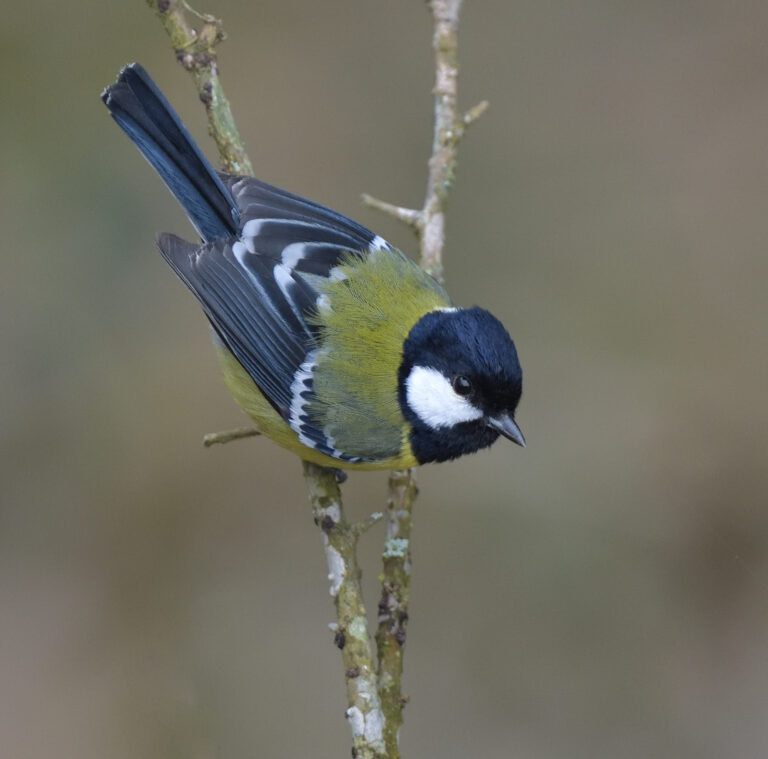
It’s raining for the first time on the trip as we set off this morning along the SNH-15 Praling road to explore the nearby forested slopes of yet another deep river valley. Despite the poor conditions, we soon find a pair of spectacular Great Hornbills in a roadside tree, apparently oblivious to their audience as they preen and feed on small fruits with their enormous and ornately casqued yellow bills. Strolling on, as the rain eases, we find a mobile mixed flock of Silver-eared Mesias, White-hooded Babblers, White-browed Scimitar Babblers, Pale-billed Parrotbills and Lesser Necklaced Laughingthrushes. Other sightings here include Bar-winged Flycatcher Shrike, Yellow-vented Warbler, Bronzed Drongo, Black-chinned Yuhina, Streaked Spiderhunter and Verditer and Ultramarine Flycatchers.
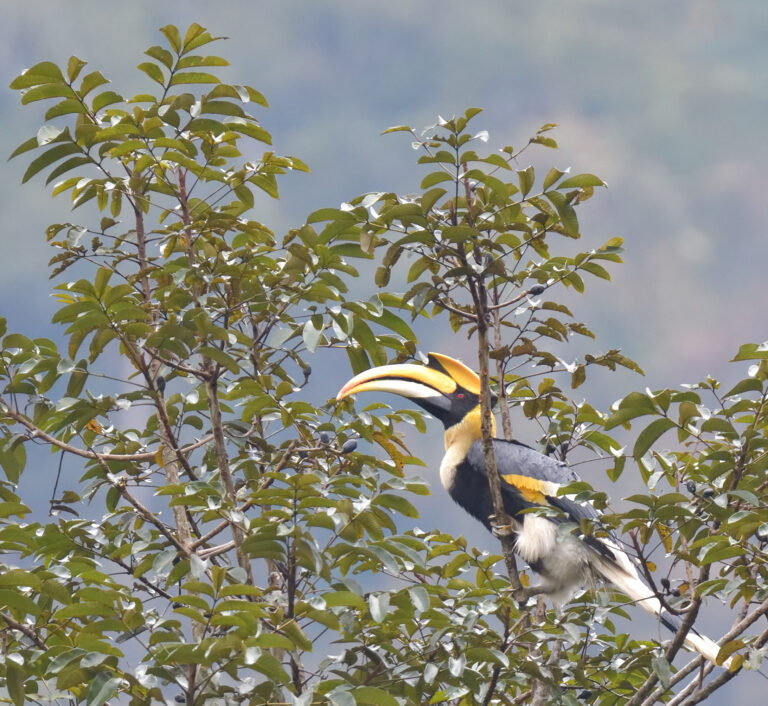
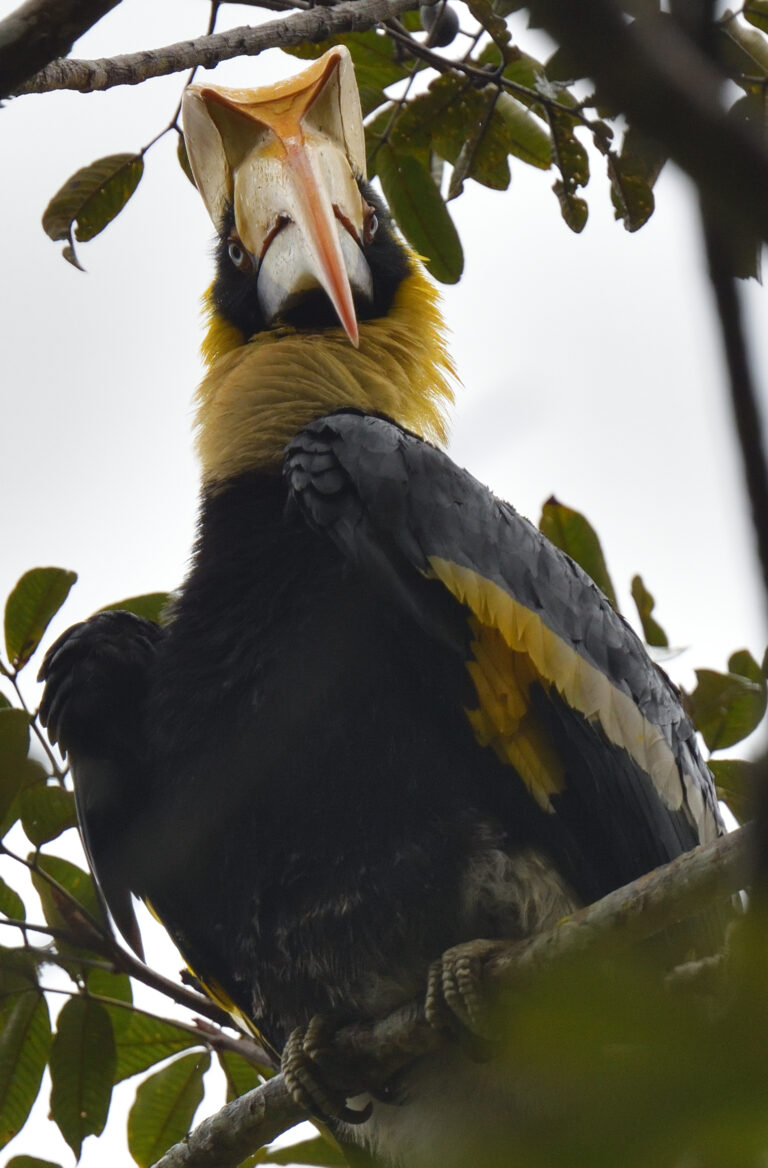
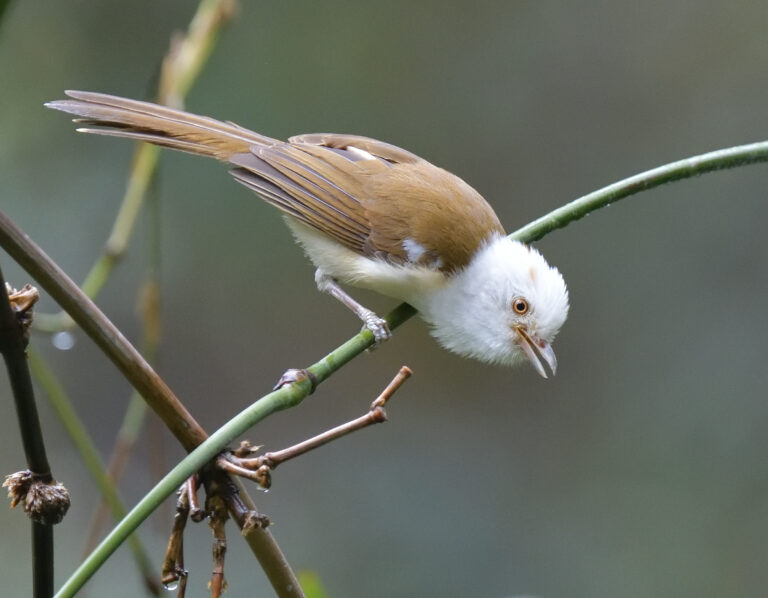
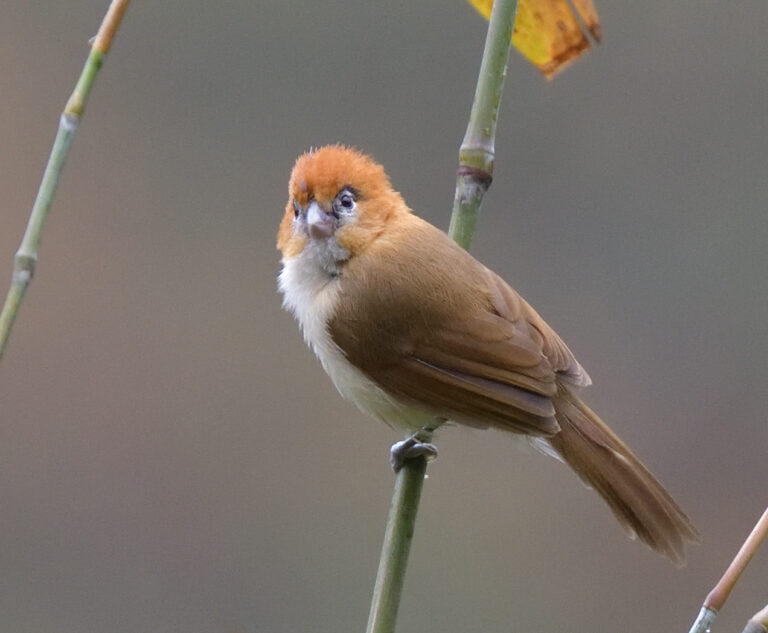
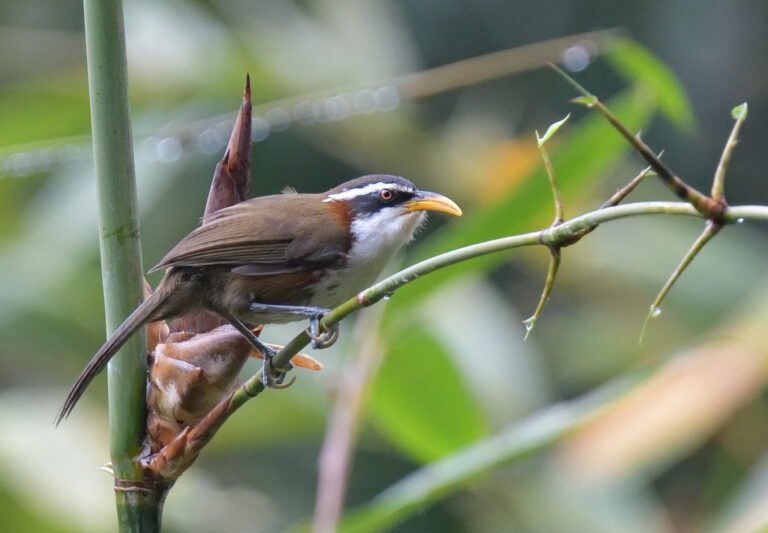
After lunch back at the hotel, on another brief sortie in the same area, we find Great and Rufous-necked Hornbills in the same tree, and then a flock of Long-tailed Sibias, and a couple of Sultan Tits, with high pointed yellow crests and a rival to the Great Hornbill for ‘bird of the day’.
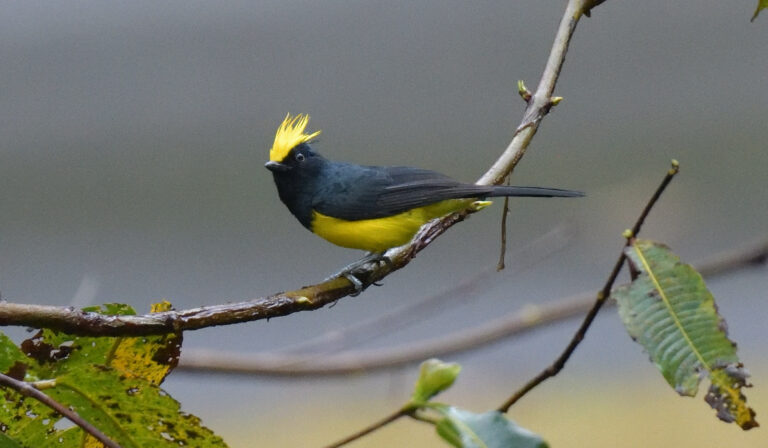
After a second night of heavy rain, the clouds lift as we leave Tingtibi on the PNH-5 Trongsa road, which is strewn with rocks washed down by the recent rains. First new bird along the way is a Barred Cuckoo Dove, and on the first stroll from the vehicle we begin with very close views of a pair of Grey-capped Pygmy Woodpeckers, about the size of our Lesser Spotted Woodpecker, and then we spot Grey-backed Shrike, Lesser Yellownape, Blue-throated Blue and Little Pied Flycatchers, White-throated and Mountain Bulbuls, Grey-cheeked and Yellow-vented Warblers and a male Red-headed Trogon. Along the road we also see several Golden Langurs, and while stopping to look at a particularly close one, our guide hears the repetitive high pitched whistling song of the Spotted Elachura which has haunted us on several occasions without showing, as it’s another ‘super Ninja’ skulker. Undaunted, we patiently stand at the side of the road again, and eventually this time, this tiny wren-like bird gives two or three brief glimpses. Hooray, at last! Further on, we stop for elevenses in warm sunshine, with Blyth’s Fork-tailed Swifts and a Mountain Hawk Eagle in the blue sky overhead.
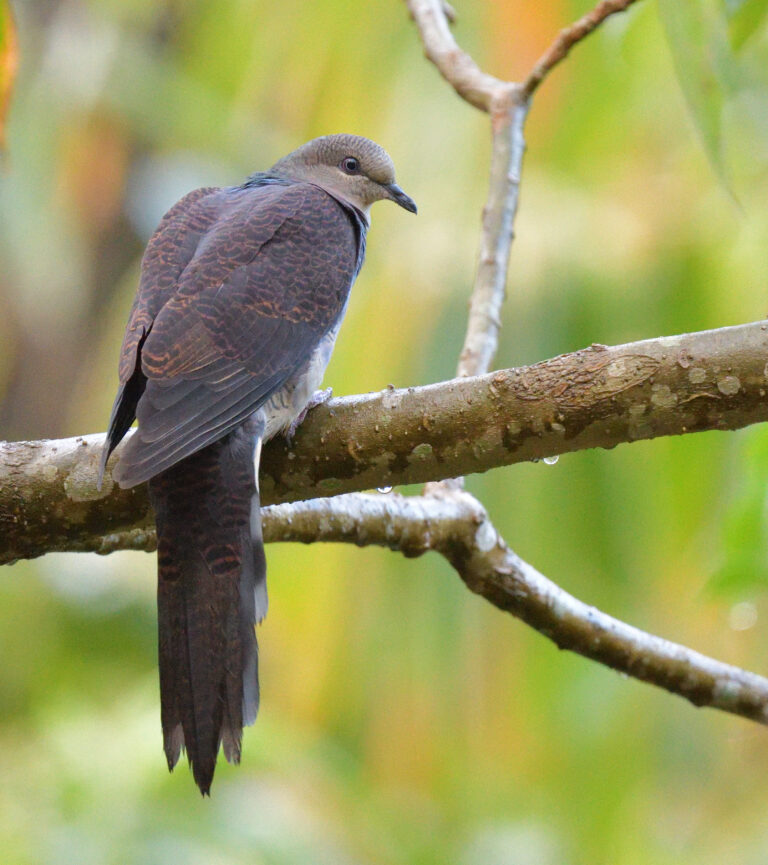
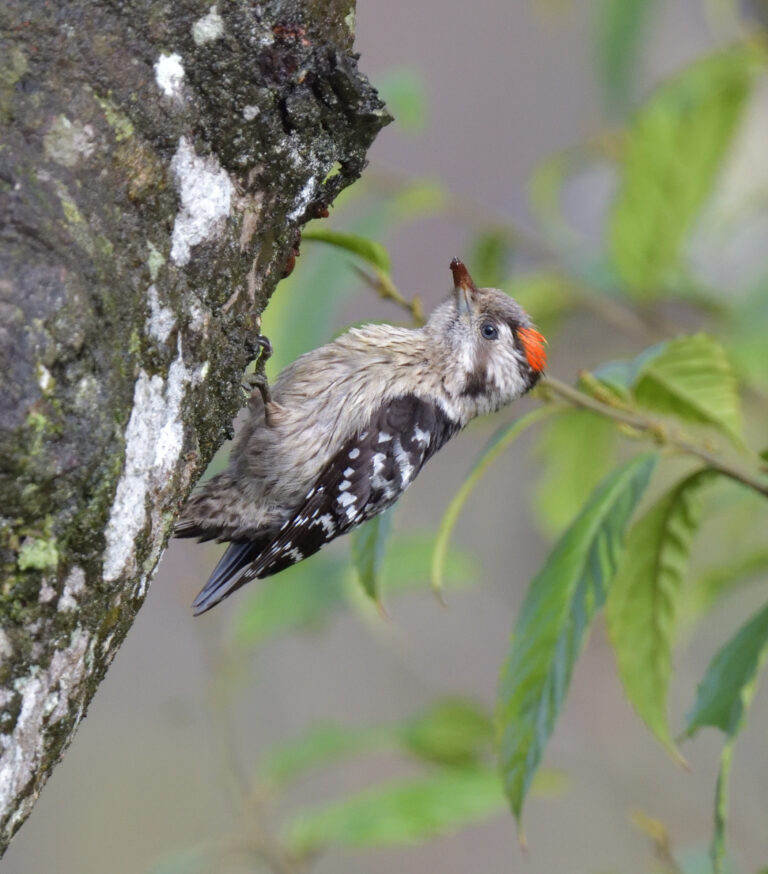

After lunch at a posh restaurant in Trongsa, overlooking the seventeenth century fortress at around 6900 feet, we join the PNH-01 Trashigang road which climbs up to the misty snow-covered Yotongla Pass at an altitude of about 11350 feet. Beyond the pass, we turn onto a very convoluted dirt track up to the Tharpaling Monastery, where numerous 180 degree hairpin bends, made worse by the mud and snow, create a stomach-churning drive. Outside the monastery gates at around 11800 feet, Alpine Accentors are ‘car park’ birds, but there is no sign of our main target, the Himalayan Monal, a spectacular rainbow-coloured pheasant, probably frightened away by several dogs and a lot of noisy wood-chopping monks! Journey’s end today is the cosy Chumey Nature Resort at a cool 9200 feet above sea level.
This morning, we follow the PNH-2, yet another road which winds its way through thickly forested slopes, this time up to the Thrumshingla Pass. Along the way, we find Black-rumped Magpies and spot a couple of iridescent purple, green and copper male Himalayan Monals at the roadside which quickly disappear into the forest. Higher up, we get close views of a Rosy Pipit and then a very obliging male Blood Pheasant, a stocky steel-grey bird with white speckles and splashes of blood-red on the throat and tail. Higher still, the road is reduced to one track by at least six inches of recent snow, making a treacherous ascent for our driver, and then we come head-to-head with a lorry, creating an impasse which lasts for at least an hour while other vehicles converge from both directions and a growing crowd of people gesticulate indecipherably about how to resolve the situation, while there’s an unattended snowplough parked lower down the road! After at least an hour, and a lot of manoeuvring by our skilful driver, we get into a position where the lorry and all subsequent vehicles can pass, and we are back on track. After some pushing by the guides, Ron and I, we eventually reach the top of the pass at a breathtaking 12400 feet, but with low mist and sleet there is little to see, so we drive on down the other side.
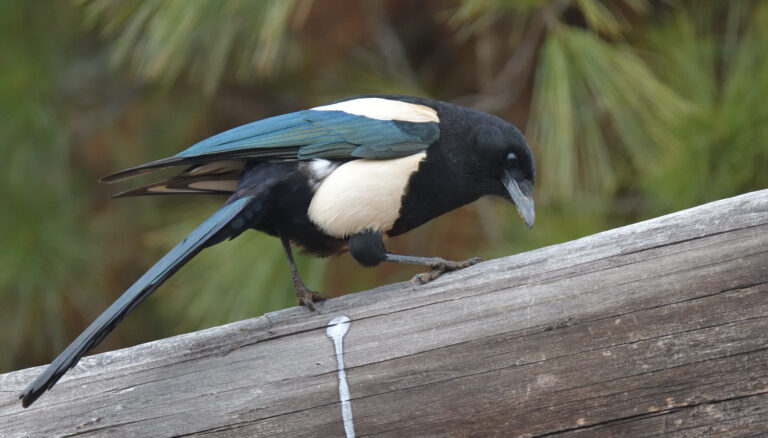
After lunch in a roadside inn, we follow the famous Limithang Road, legendary as one of the top birding sites in the whole of Asia, and reminiscent of an Andean cloud forest, with steep slopes, tall trees festooned with epiphytes and mist billowing up from below, but in the poor visibility we only spot Green-tailed Sunbird, White-tailed Nuthatch, Yellow-cheeked Tit and Bar-throated Minla, so head for the nearby Trogon Villa to check in and have a well-earned cuppa, before having a second crack at the road above the villa. This time, we find a fast-moving mixed flock, lead by a Lesser Racket-tailed Drongo, with an entourage including Greater Yellownape, Green Magpie, Sultan Tit, Little Pied Flycatcher, Himalayan Cutia, Rusty-fronted Barwing, Black-headed Shrike Babbler, and best of all, the Beautiful Nuthatch, another of the main targets of the trip. With rain still pouring we call it a day at 4pm and head back to the villa, which is at an altitude of 7200 feet. Apparently, this wet weather is so unusual that our guides haven’t packed any rain gear!
Hooray, there is a lovely blue sky this morning as we return to a stretch of the upper Limithang Road, where first find, thanks to their hoarse coughing calls, is a pair of Rufous-necked Hornbills. Next, we list a steady stream of birds in the following order of appearance; Black-faced Warbler, White-throated Laughingthrush, White-throated Fantail, Grey-headed Canary Flycatcher, Striated Laughingthrush, a bush full of Ashy-throated Warblers, then Scarlet Minivet, White-tailed Nuthatch and Sikkim Treecreeper. Then we hear the unmistakeable repetitive haunting whistle of another Spotted Elachura, which has now wormed its way into our heads, and the score is now six one to the Elachura! More obliging birds here include White-breasted Parrotbill, Rusty-fronted Barwing, Black-throated Sunbird and a Golden-throated Barbet calling from the top of a bare stump.
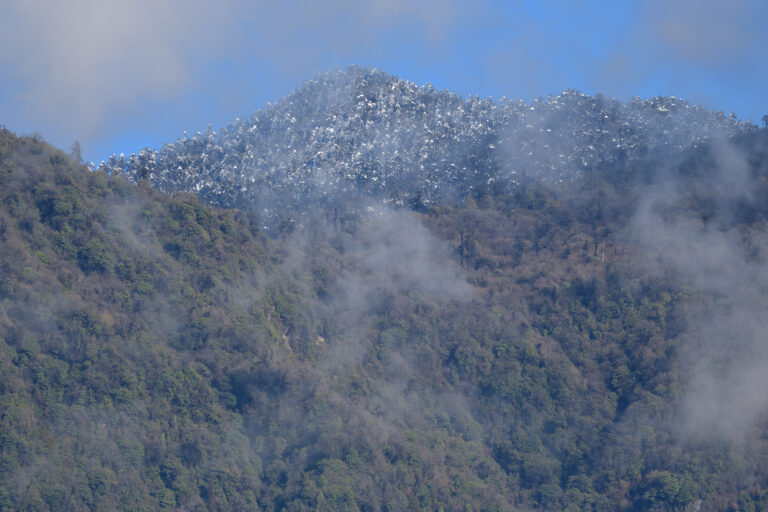

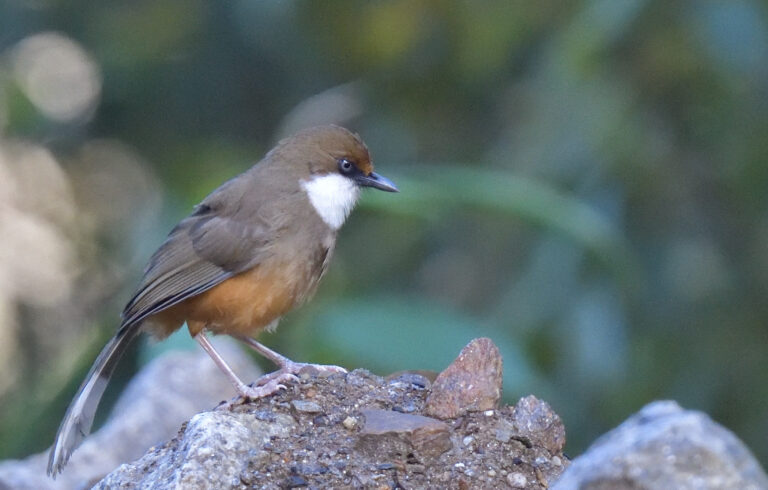
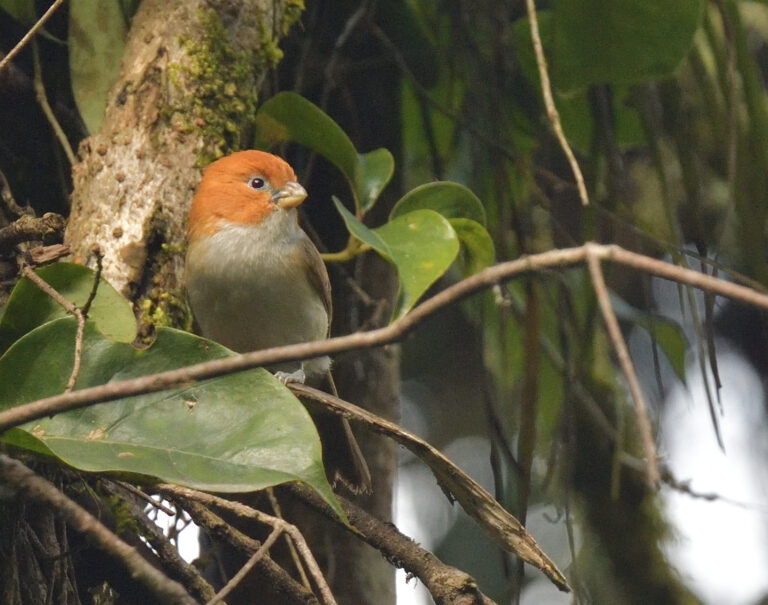
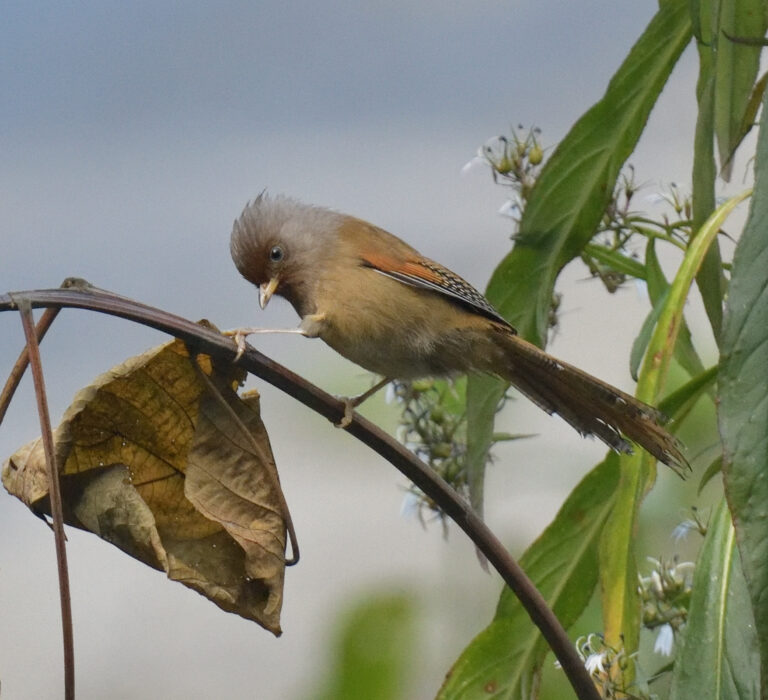
Straight after our tea break, served at the side of the road, we scope an Asian Emerald Cuckoo, glistening in the sunshine. It’s now 11am and the bird activity is quieter, although we still find Whiskered Yuhina, Black-throated and Sultan Tits, Grey-sided Bush Warbler and a soaring Black Eagle, while White-browed Shrike Babbler is new for the trip, and on the way back to the villa for lunch we pass a group of Capped Langurs sitting at the roadside, making all three langurs one can see in Bhutan, and so that was quite a productive morning, and all amid spectacular forested mountain scenery.
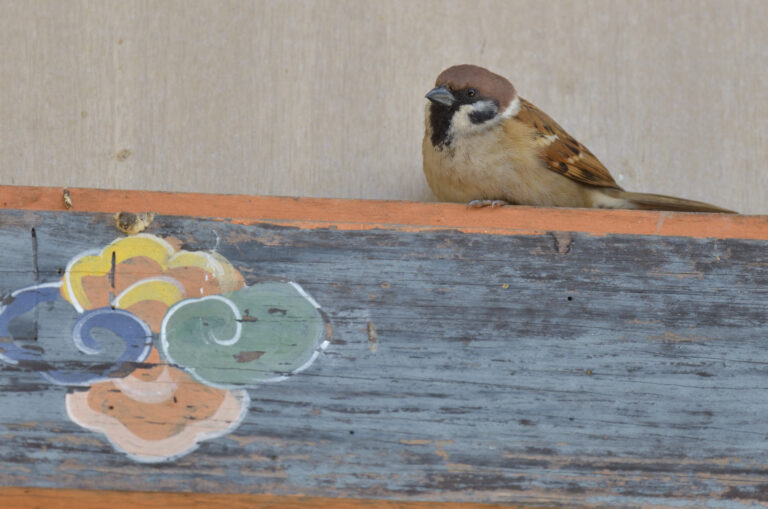
After some free time at the villa to watch local birds like Tree Sparrow and Long-tailed Shrike, the first new bird of the afternoon is a Common Tailorbird right outside the villa as we set off to explore the nearby Tsamang Road which winds through more beautiful tall broadleaved evergreen trees, constantly dropping leaves a few at a time. Strolling along the road we soon find a troop of very relaxed Capped Langurs, with a very young, totally blonde baby, whereas the adults are mainly dark grey. A female Orange-bellied Leafbird also shows well in the same tree, and then the next new bird is the finely marked Striated Bulbul. Fifteen minutes later, the next new bird for the trip list is a real ‘belter’. Not one, but eight absolutely fabulous Long-tailed Broadbills, which are mainly green with black and yellow heads and royal blue tails which they can swing 90 degrees to one side and then a full 180 degrees in the other direction! This must be one of the most remarkable birds I have ever seen! Next, we enjoy scope views of a pair of Golden-throated Barbets, showing almost every colour of the rainbow, followed by Grey-headed Canary Flycatcher, a calling Great Barbet in the scope, Yellow-crested Tit, an Asian Barred Owlet with its head turned a full 180 degrees to stare at us, and finally, a pair of Kalij Pheasants on the road ahead of the vehicle on the way back to the villa.
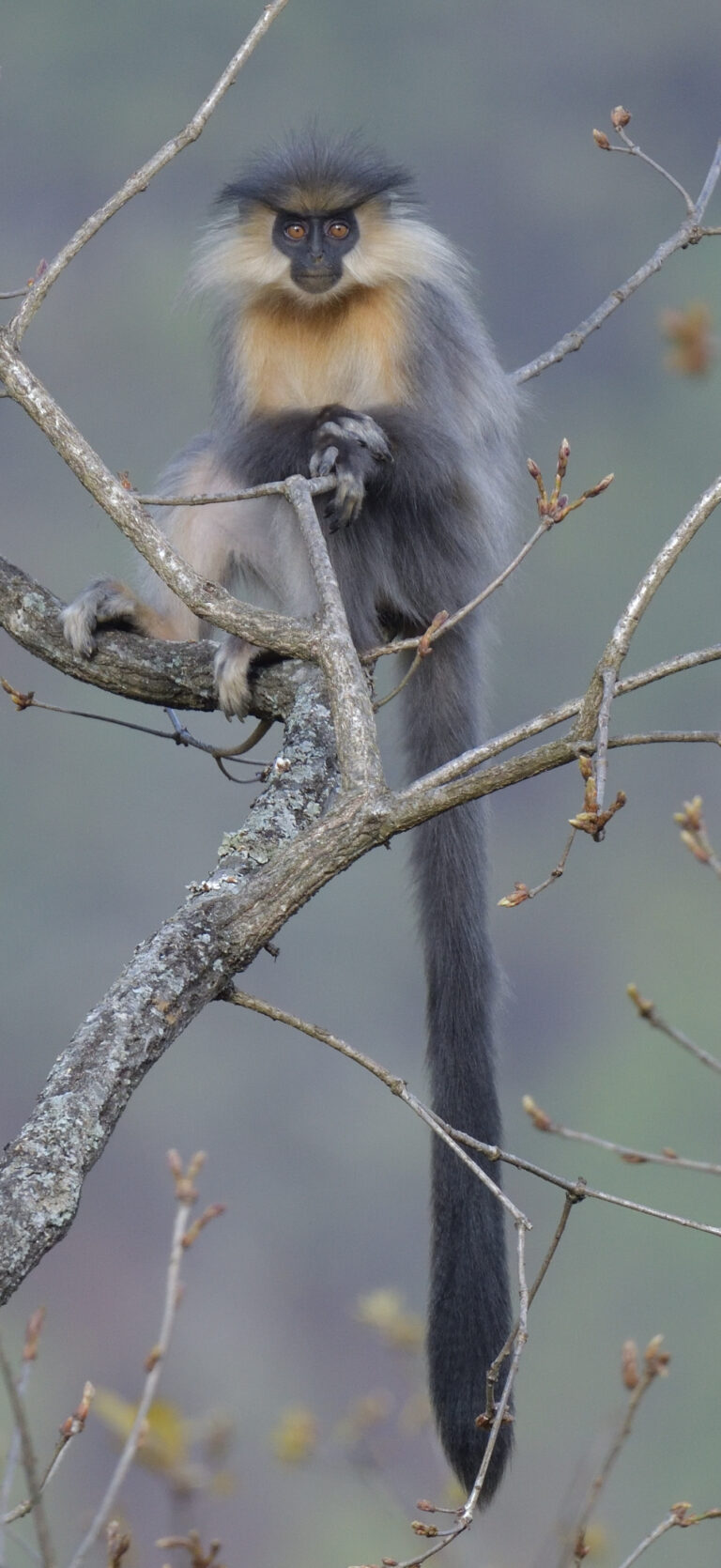
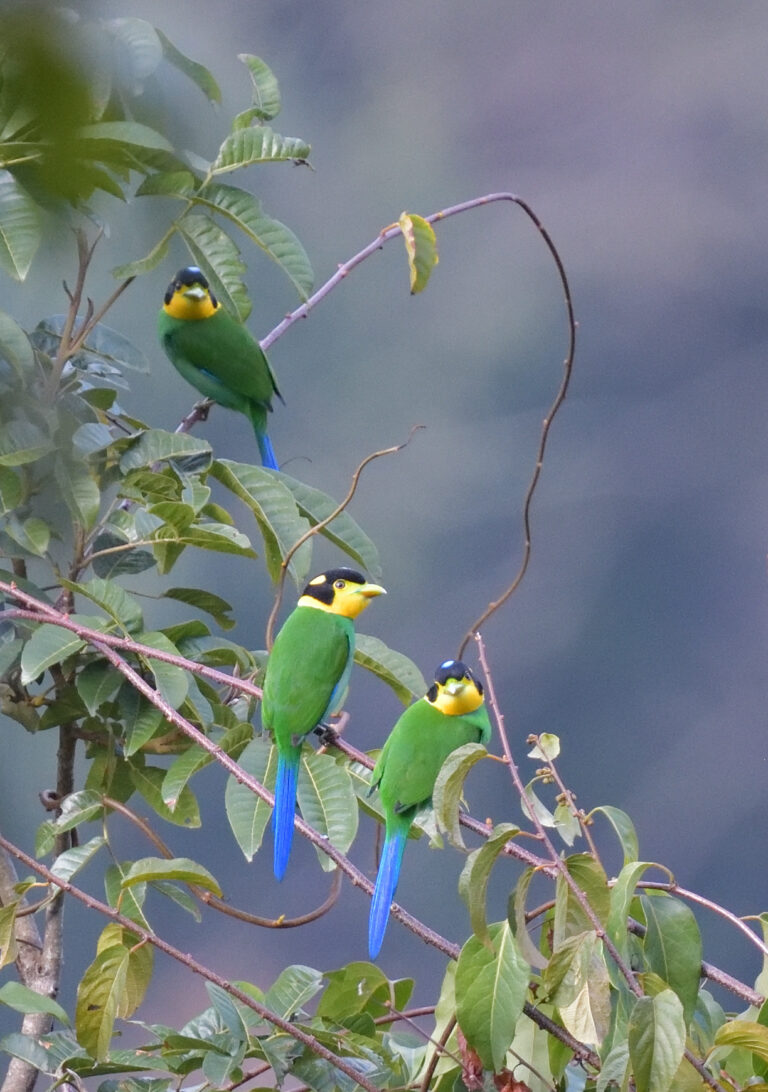
After breakfast at 5am, we head off down the road to Limithang and take a side road, finding a Little Bunting in a small area of cultivation before entering more prime broadleaved evergreen forest. Along the way, our guides hear a Chestnut-headed Tesia, so we stop for a look and eventually all get nice close views of this attractive little skulker, while a Slaty-bellied Tesia calling from the same spot is far less obliging. Moving on into another small area of cultivated land we find Grey Bushchat, Long-tailed Shrike, Russet Sparrow, Rusty-cheeked Scimitar Babbler and Barred Cuckoo Dove. Higher still, we alight from the vehicle for a stroll along the quiet narrow winding road, where our first sighting is a secretive Scaley Laughingthrush deep in the undergrowth. Further on, Norbu frantically beckons us back for “Sikkim Wedge-billed Babbler” and we probably spend the next half an hour staring at the sloping side to the road and peering into the shrubbery while up to three of these frustrating birds quickly dash back and forth across gaps in the vegetation. Eventually we all manage to see brief views of the whole bird which is dark chocolate brown with fine white streaks on the mantle, a crescent-shaped silver supercilium and a very sharply pointed wedge-shaped bill.
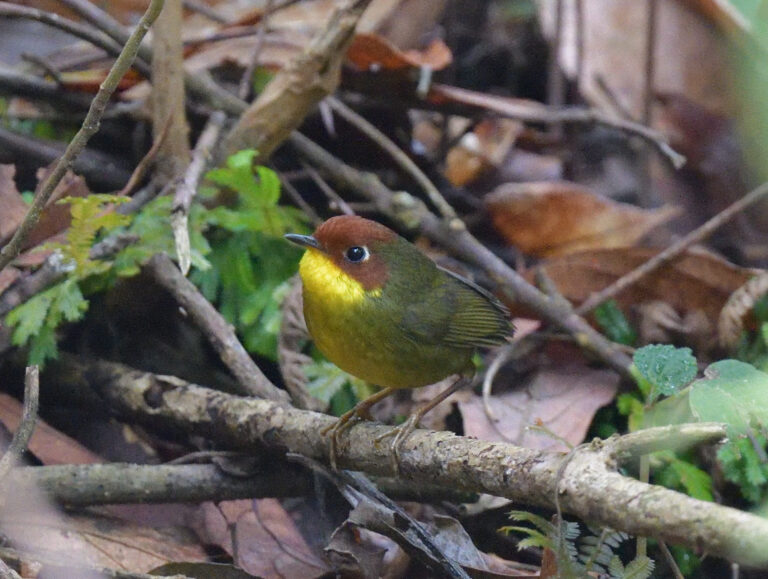
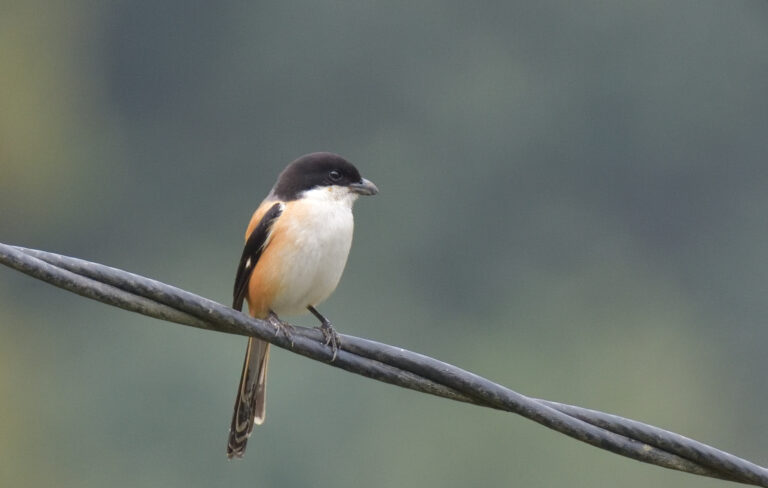
After a tea break at the roadside in pleasant sunshine, we find a flock of Grey-chinned Minivets, some Black-throated Bushtits, a couple of Striated Laughingthrushes, another Sikkim Treecreeper and more pieces of the Mountain Tailorbird jigsaw, as we find another one showing much better this time, with a head pattern that looks reminiscent of a Firecrest. It’s now time for another ‘skulker stakeout’, which is fairly short this time, as we don’t have to wait long for a calling Long-billed Wren Babbler to show itself a couple of times amid some very low twigs at the side of the road. So, that’s three super skulkers in one morning, and all thanks to the knowledge and experience of our hard-working local guides. Strolling on, a flock of Blyth’s Swifts passes over as if on migration and then we find our first ‘true thrush’, a Grey-winged Blackbird, which is exactly what it says on the tin. Meanwhile, a flock of Himalayan Swiftlets passes over, with grey rather than white rumps. We also find a group of Rufous Sibias bathing in a small pool and end the morning session with a flock of Striated Bulbuls feeding on tiny orange berries growing on one of the many tall trees.
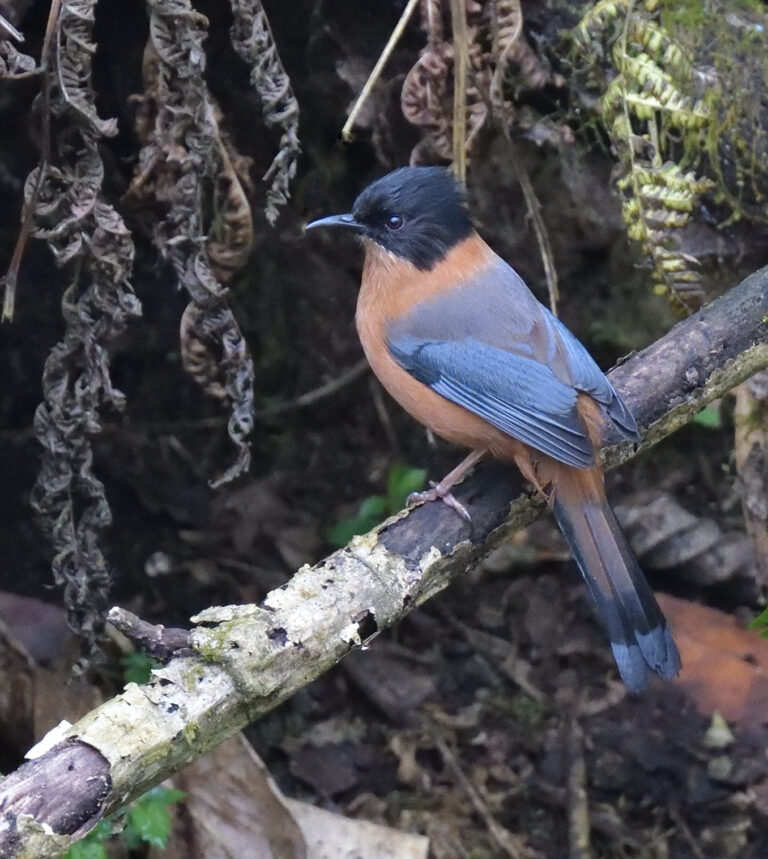
Our picnic lunch is rudely interrupted by steadily heavier rain, accompanied by distant thunder, and by the time all is packed back into the vehicle, the rain has become a monsoon, which is usually from July to September in Bhutan, whereas March is supposed to be the ‘dry’ season! Given the deluge, we have no option other than to return to the villa for afternoon tea and some free time to delete lots of photos!
It’s still overcast and damp this morning as we set off down the Limithang Road, where the first stroll begins with a White-throated Fantail and a tree full of birds like Grey Treepie, Golden-throated Barbet, Rufous Sibia, Orange-bellied Leafbird, Streaked Spiderhunter, Black Bulbul and Verditer Flycatcher. Strolling on downhill, we find Nepal Fulvetta, Ashy and Hair-crested Drongos, Whiskered Yuhina, Rusty-fronted Barwing, Bar-winged Flycatcher Shrike, a Scarlet Minivet with a large green grasshopper in its bill and a very obliging Rusty-cheeked Scimitar Babbler. Next, we hear our old adversary, the Spotted Elachura, which again haunts us with its repetitive whistle, without showing, making the score now seven two to the Elachura! Further on, another mixed flock includes Fire-breasted Flowerpecker, Black-chinned Yuhina and Ashy Bulbul which is new for the trip. Lower still, a second stroll, this time in an area of small, terraced fields, produces birds like White-throated Kingfisher, Grey Treepie, Grey-headed Woodpecker, Grey-backed and Long-tailed Shrikes, Oriental Magpie Robin, White-capped Redstart, Rufescent Prinia, Little Bunting, a flock of Rufous-necked Laughingthrushes, a posing Crested Bunting with a very spikey crest and an obliging pair of Black-tailed Crakes. We are not back in the vehicle for long before we get out again to scope a Himalayan Buzzard sitting in a treetop, with Yellow-bellied Flowerpeckers also nearby, which is another new bird for the trip.
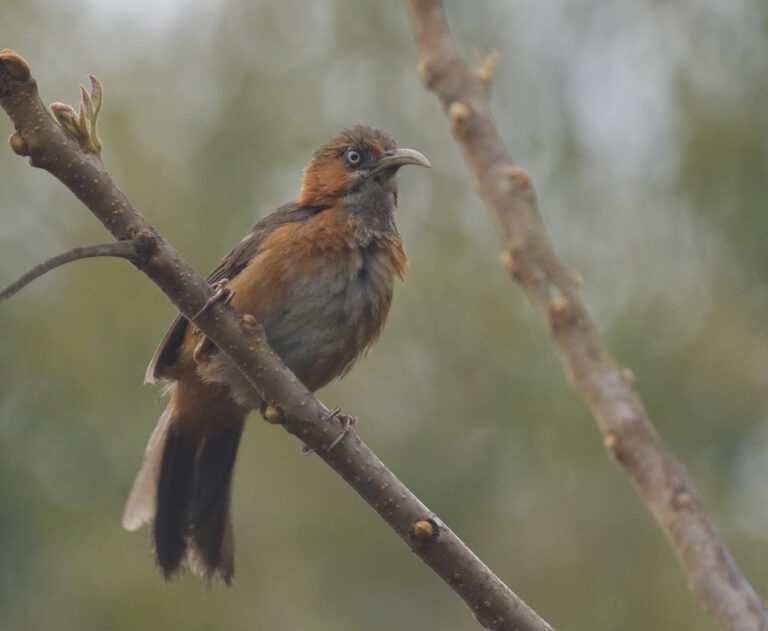
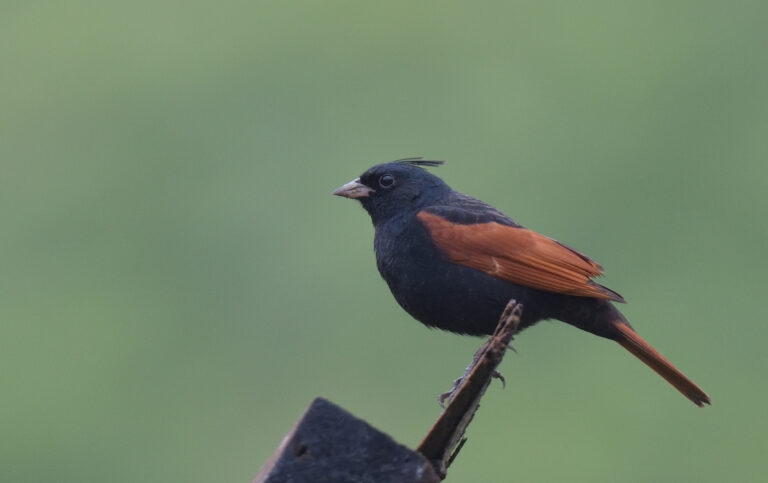
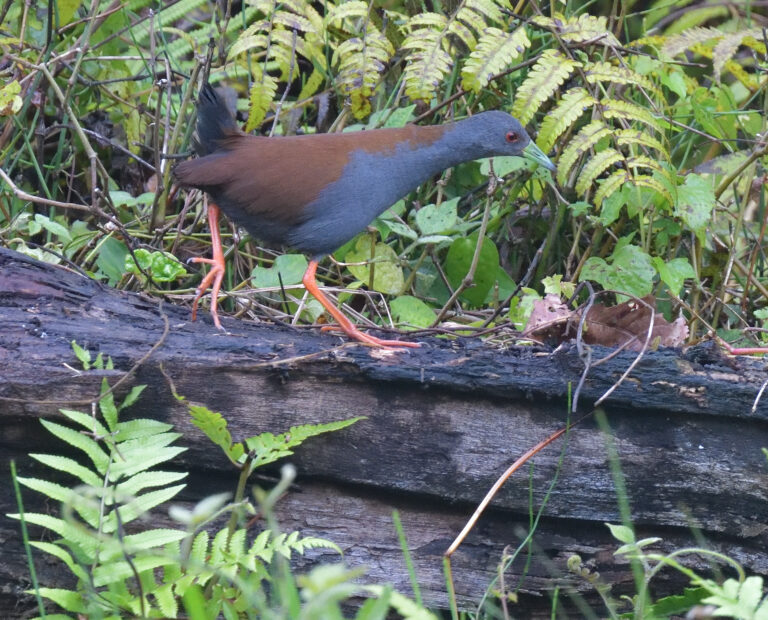
It’s now late morning, as we set off on foot along a rough track alongside the Limithang River, where a ‘purple patch’ produces Scarlet Minivet, Scarlet Finch and Crimson Sunbird. Our main goal here is to find a roosting Tawny Fish Owl, and after a short walk, there it is, snoozing high up on a horizontal branch, while occasionally looking down at us with large yellow eyes positioned between long flattened ear tufts. Standing two feet tall with a barrel-shaped body, this is a very impressive owl. Back at the vehicle, it’s time for elevenses, with a nearby Himalayan Bulbul in the scope, which is also new for the trip. Our tea break is then interrupted by a calling Blue-naped Pitta, but despite a valiant effort to find the elusive bird in the dense undergrowth, there is no sign, though we do get good views of White-throated Bulbul, plus White-crested, White-throated and Lesser Necklaced Laughingthrushes.
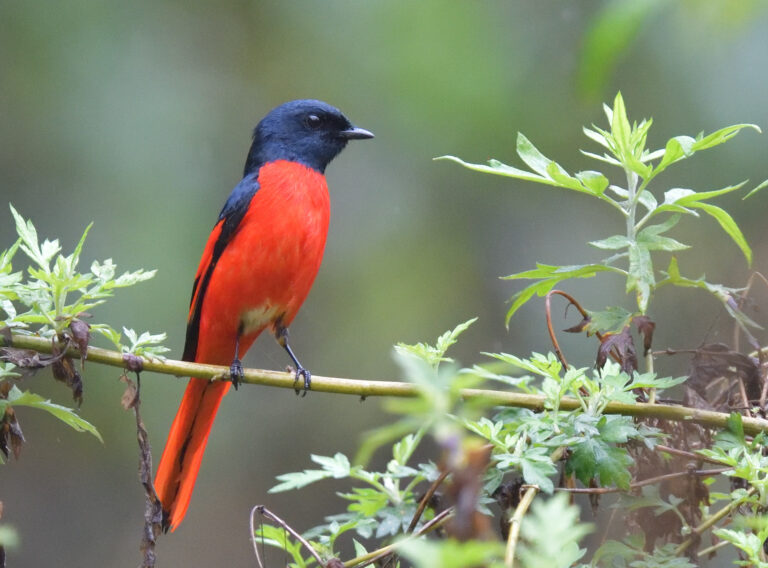
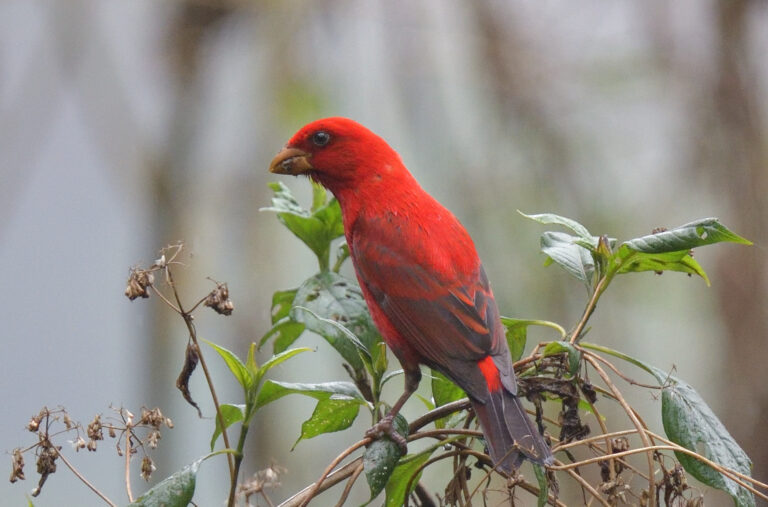
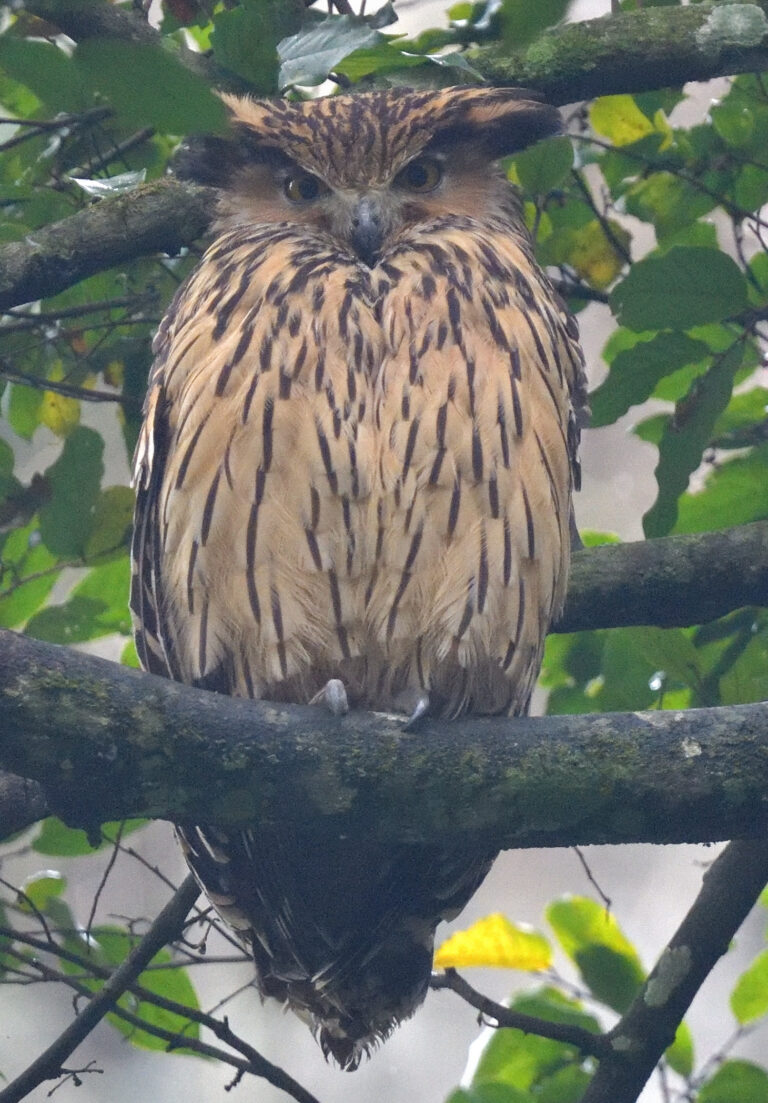
After lunch back at the villa, the drizzle has finally stopped as we drive up the Limithang Road, where patches of mist are hanging amid the tall trees, though we get good views of another three pairs of Rufous-necked Hornbills, and eventually, a pair of chunky Himalayan Cutias, as well as White-naped Yuhina, White-breasted Parrotbill, Red-faced Liocichla, White-tailed Nuthatch and Black-headed Shrike Babbler. On the way downhill, we revisit the Tsamang Road and find a Malayan Giant Squirrel posing on a branch. Further on we find more Scarlet Minivets, another Streaked Spiderhunter and Striated Laughingthrush, and eventually, a pair of superb Beautiful Nuthatches, our main target here. In the same scope view, we also see Chestnut-bellied Nuthatch, making three different nuthatches on this very productive day!
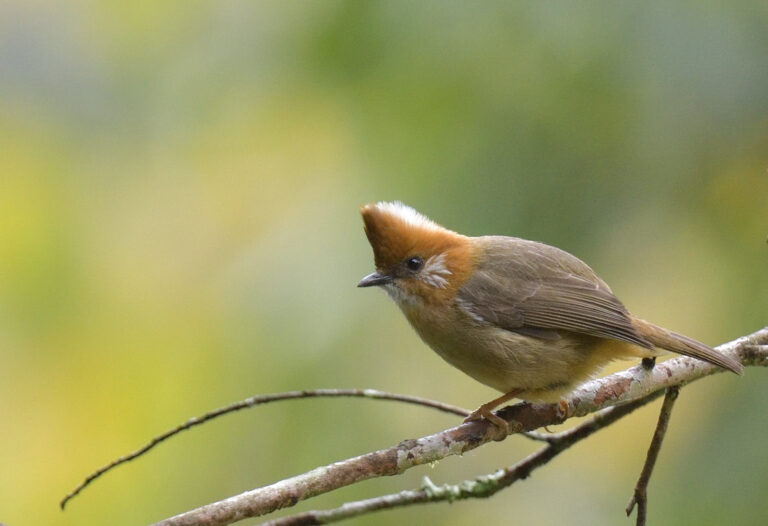
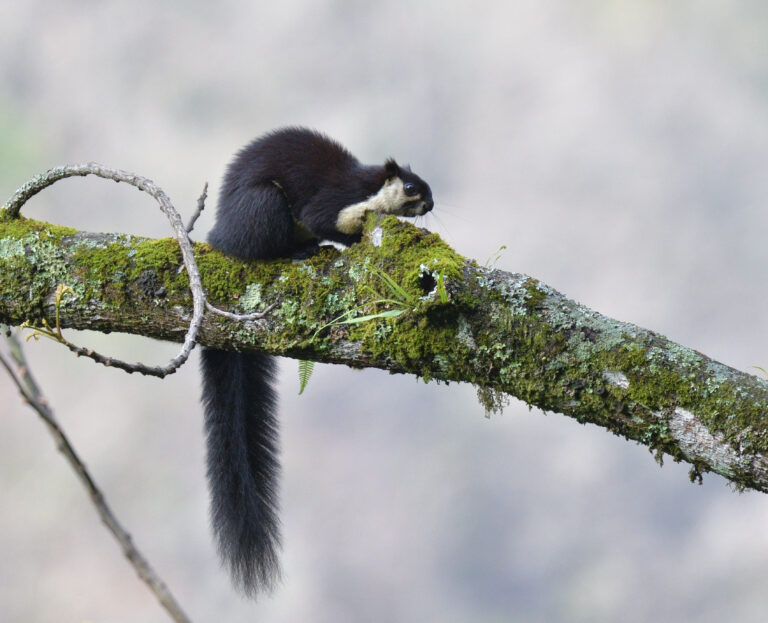
It’s our last breakfast of perfectly cooked fried eggs before we leave the villa for the last time and drive downhill, hoping to find yesterday’s calling Blue-naped Pitta. We arrive at 6.30am and although the bird is calling, the vegetation is too dense to see it, so we make do with Oriental Magpie Robin, White-crested Laughingthrush, a flying Great Hornbill and Plumbeous Water Redstart on a boulder in the nearby river.
It’s a long uphill drive from here back up the Limithang Road, where first new bird of the day is a smart male Blue-capped Rock Thrush, followed by many of the usual suspects like Green-tailed Sunbird and Yellow-cheeked Tit as we retrace our route until we reach new unexplored biomes as the road takes us ever higher and the vegetation changes. Along the way, Nepal House Martins, building their mud nests stuck on to rock faces overhanging the road are new for the list, and at the impressive Namling waterfall, the highest cascade in Bhutan, dropping about 164 feet down to the road, we find White-capped Redstart and Little Forktail. Around midday, we arrive at a layby where a table with tablecloths and chairs has been laid by our ground crew, ready for an open air roadside lunch, watched over by a pair of Large-billed Crows.
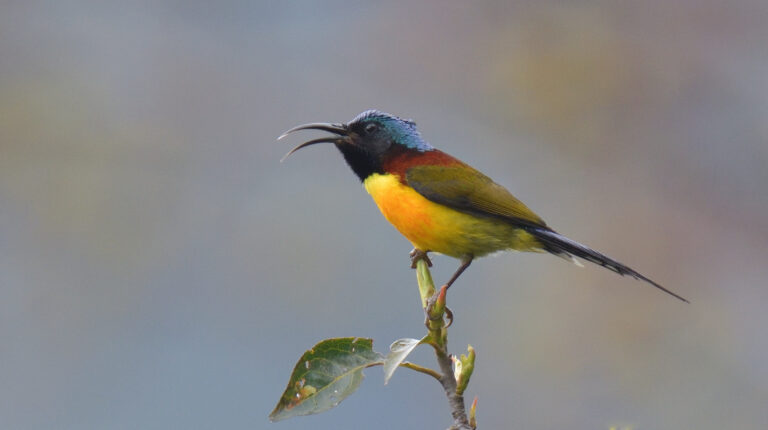
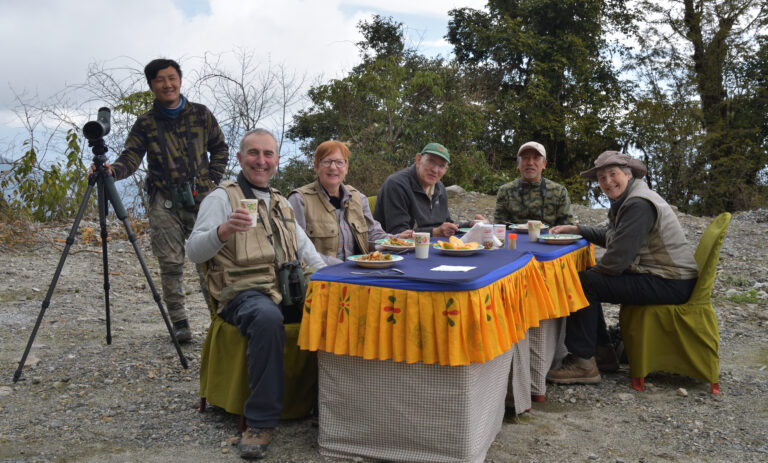
This afternoon, amid a forest of tall white-flowering Rhododendron trees we find Stripe-throated and Rufous-vented Yuhinas and Streak-breasted Scimitar Babbler, which are all new for the list. Higher still, the vegetation changes to a forest of tall, gnarled old Himalayan Yew trees, where we reacquaint ourselves with the local crested race of Coal Tit, plus Ashy-throated Warbler, Black-faced Laughingthrush and Rufous-gorgeted Flycatcher, while the vivid red Long-tailed Minivet is another new bird. Around mid-afternoon, we arrive at our new base, a tented camp, specially erected by our ground crew at an elevation of around 8700 feet, and we still haven’t reached the top of the road!
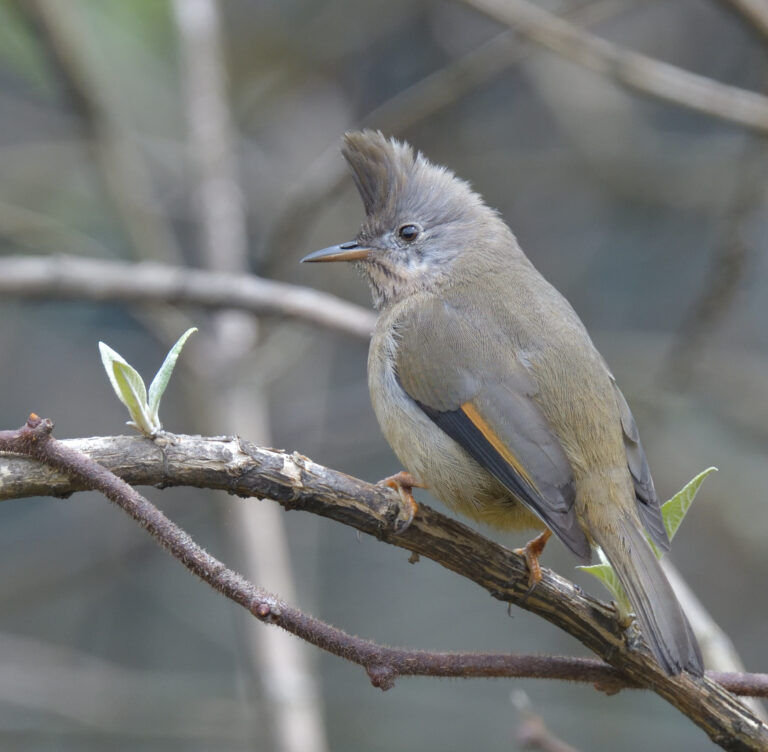
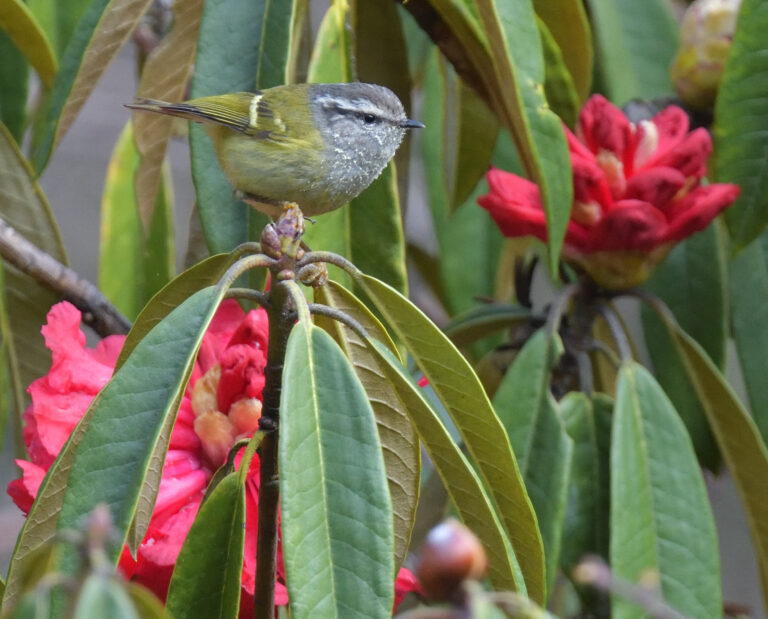
At 4pm, we drive a short way back down the road, where we find Black-faced Laughingthrush again, as well as Dark-rumped Rosefinch, and then Norbu finds another super skulker for some in the group; the tiny Bar-winged Wren Babbler. Around 5.30pm, we start to concentrate on finding what is probably the number one target bird of the entire trip, the amazing Satyr Tragopan, an exotic member of the pheasant family par excellence. This mystical bird of the high mountain forests produces a weird wailing call, rather like a lovesick cat on a Friday night! Incredibly, after playing the call a few times, we get a response from somewhere nearby in the dense undergrowth, and as the afternoon light begins to fade, a vivid red form with numerous white spots appears from stage left. This ‘star of the show’ slowly struts across the slope, now partly concealed by foliage but visible enough to show its large dark eyes and brilliant blue wattled skin on its throat, while occasionally uttering its haunting call. Another remarkable sighting on this star-studded trip.
After dinner back at camp, while still dressed in our outdoor clothes, we decide to go for a short owling session. After a walk of little more than 300 yards, Norbu points his torchlight up to the right, and there on a bare branch is a Himalayan Owl! That was possibly the shortest owling session ever!
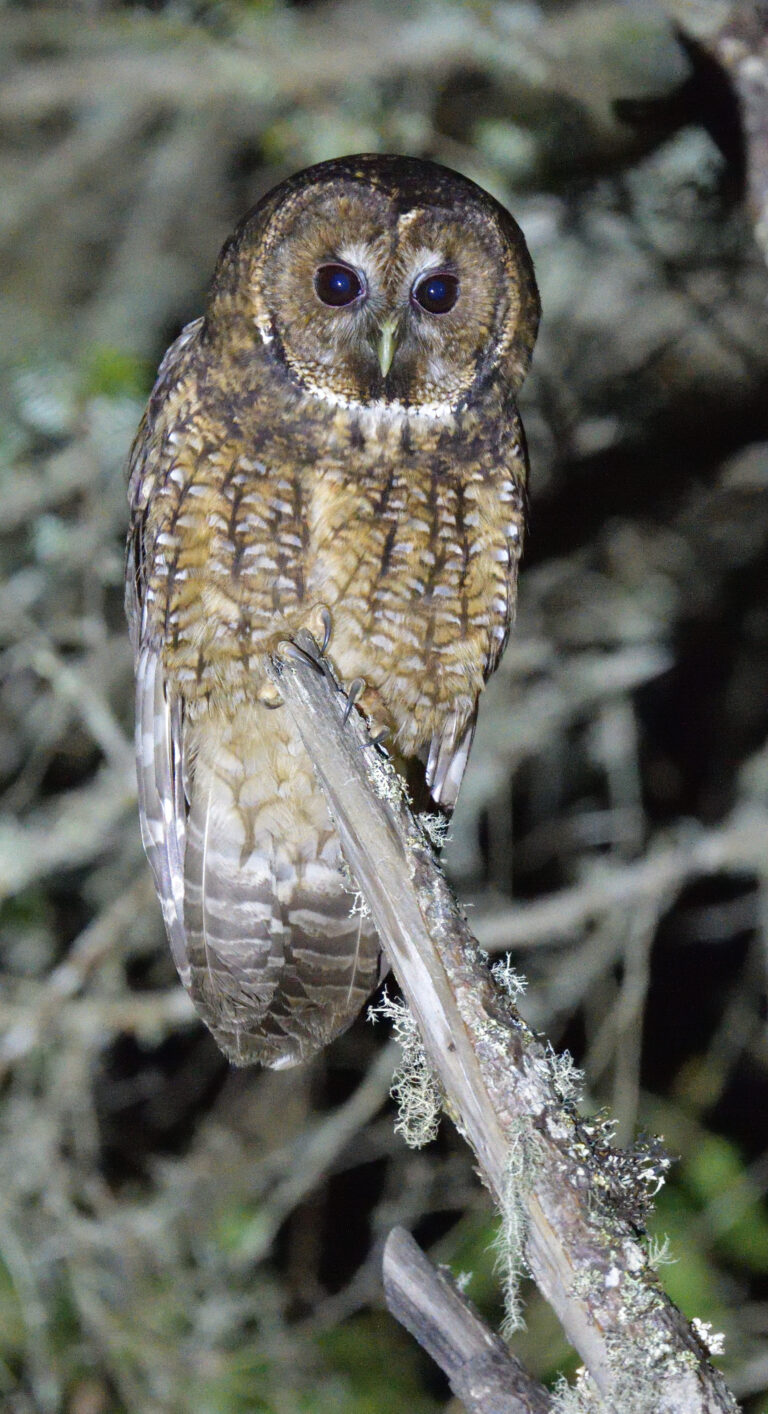
Next morning, having exchanged stories of our overnight camping experiences, we drive off up the road at 6am, with the vehicle thermometer reading 5°C! No wonder there is snow on the ground once we alight from the vehicle for a stroll downhill. Passing a sign saying Red Panda Habitat, there is no sign of this lovely rare animal, but we do find a nice selection of new birds such as White-throated Needletail, White-browed Bush Robin, Hodgson’s Treecreeper, a very obliging and vocal Great Parrotbill and a party of Red-headed Bullfinches, as well as a group of Blood Pheasants busy feeding on the forest floor, and an Orange-bellied Squirrel which scampers across the road in front of us. At the end of the stroll, our table awaits for breakfast on the snow, in the sunshine, amid this beautiful forest of tall Himalayan Yews.
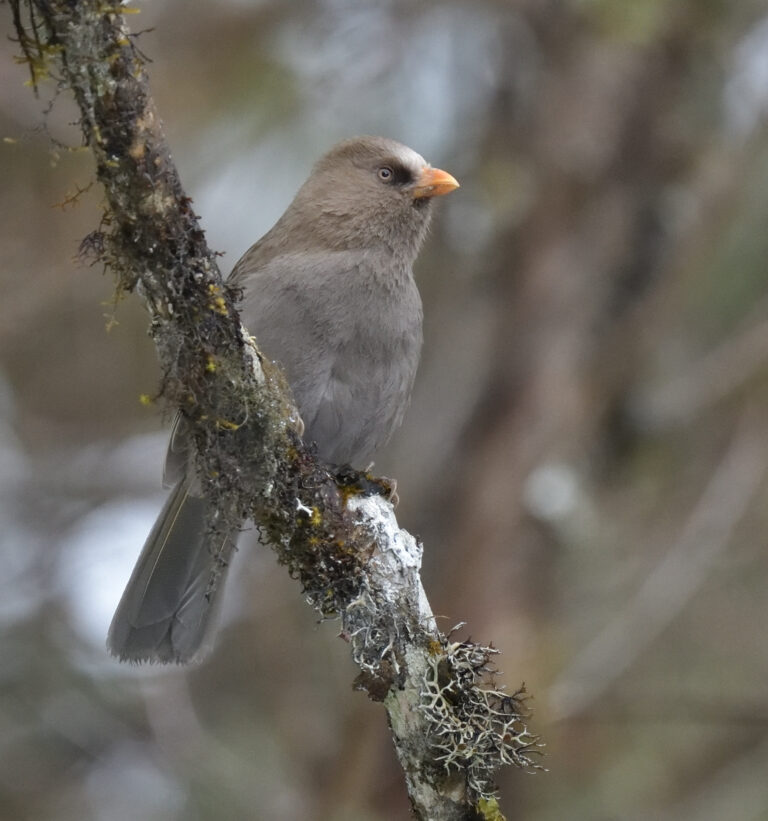
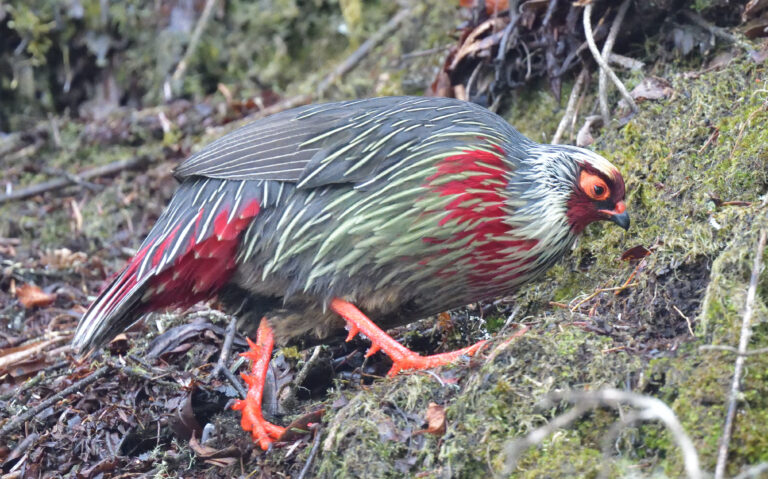
After breakfast, we continue strolling downhill, finding more birds like Rufous-breasted Accentor, Rufous-vented Yuhina, Grey-crested Tit, White-browed Fulvetta, Green-tailed Sunbird, an Olive-backed Pipit singing from a treetop, a pair of Red-billed Choughs collecting nesting material, a very confiding male Black Redstart posing on a fencepost, and best of all, a pair of Fire-tailed Myzornises.
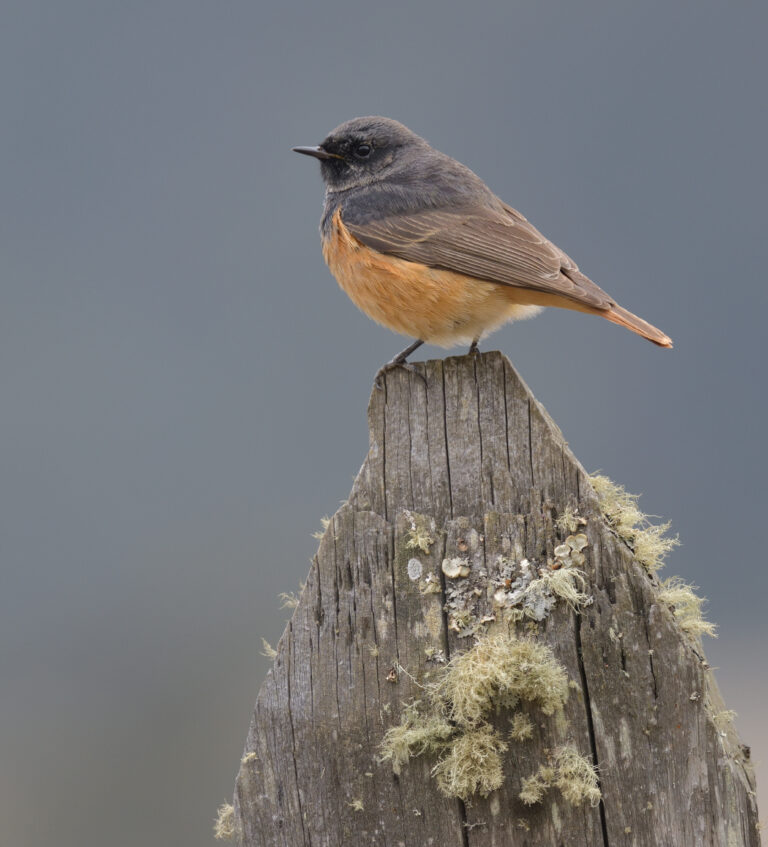
After lunch back at camp, the weather deteriorates again, becoming damp, misty and not conducive to seeing much, apart from nice views of Red-headed Bullfinches and White-collared Blackbird, which is another new bird for the trip.
It’s time to break camp and head back to ‘civilisation’ via the Thrumshingla Pass at an elevation of 11900 feet. Below the top we find three new birds, Buff-barred Warbler, Hume’s Bush Warbler and Rufous-vented Tit, but despite another search of this high forest there is still no sign of the elusive Red Panda. Moving on to the other side of the pass, we find a group of Blood Pheasants and a stunning male Himalayan Bluetail. Next, a busy flock of small birds includes Rufous-vented and Grey-crested Tits, White-browed Fulvetta and Hodgson’s Treecreeper, along with Rufous-fronted Bushtit and our very own Goldcrest which are both new for the trip.
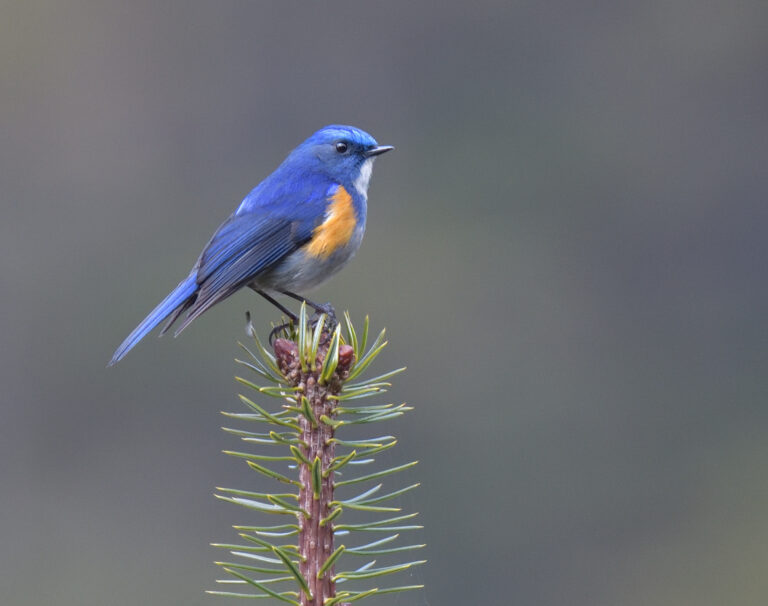
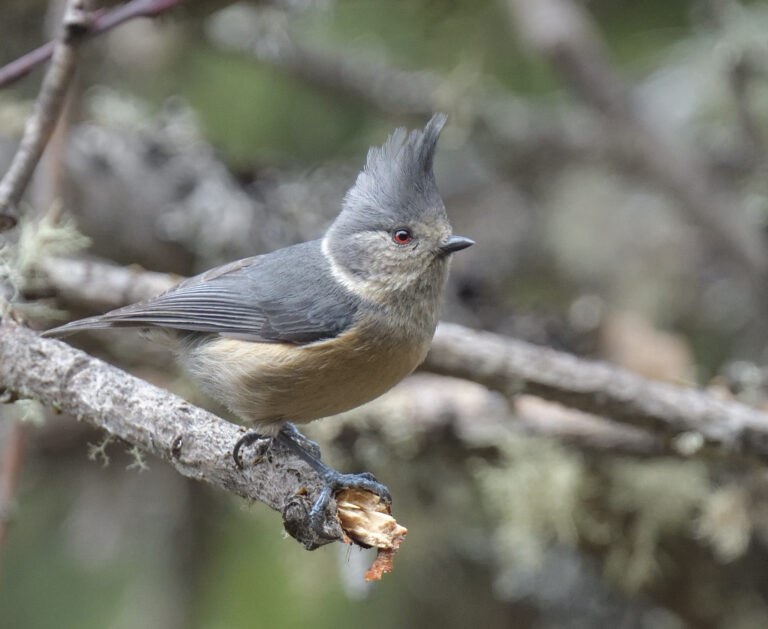
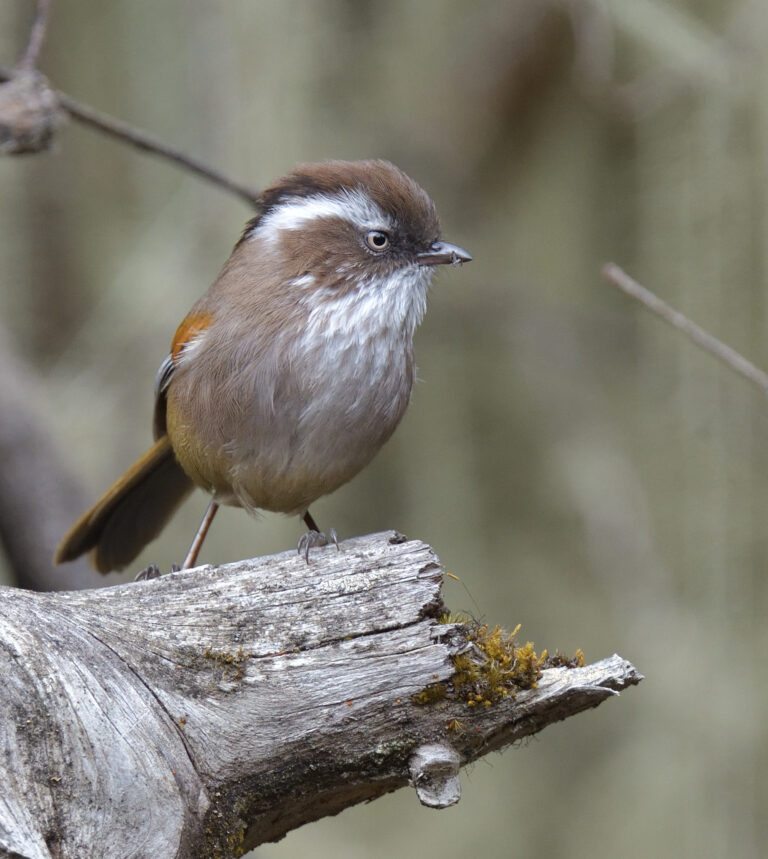
By 10am, it’s time for tea served at our roadside table, by our very own ground crew, and we enjoy a chance to soak up the warm sunshine, like lizards first thing in the morning! By late morning, as we drive ever lower, there’s a cool breeze blowing and in an area of grazing meadows, probed by at least 100 Red-billed Choughs, as well as several Black-rumped Magpies, we scope a small group of Himalayan Beautiful Rosefinches which are new for the trip. In the nearby town of Ura, we stop again to watch a group of six Himalayan Vultures circling low over the fields, and also spot a Booted Eagle amongst them. We are now on the very quiet, winding SL-02 road which passes through hills forested with conifers where we find the tiny Green Shrike Babbler and Spotted Nutcracker, both new birds, along with more Green-tailed Sunbirds, Grey-cheeked and Coal Tits and a couple of Darjeeling Woodpeckers, first seen on day two. Journey’s end is Jakar, at an altitude of almost 8500 feet and overlooked by a seventeenth century fortress.
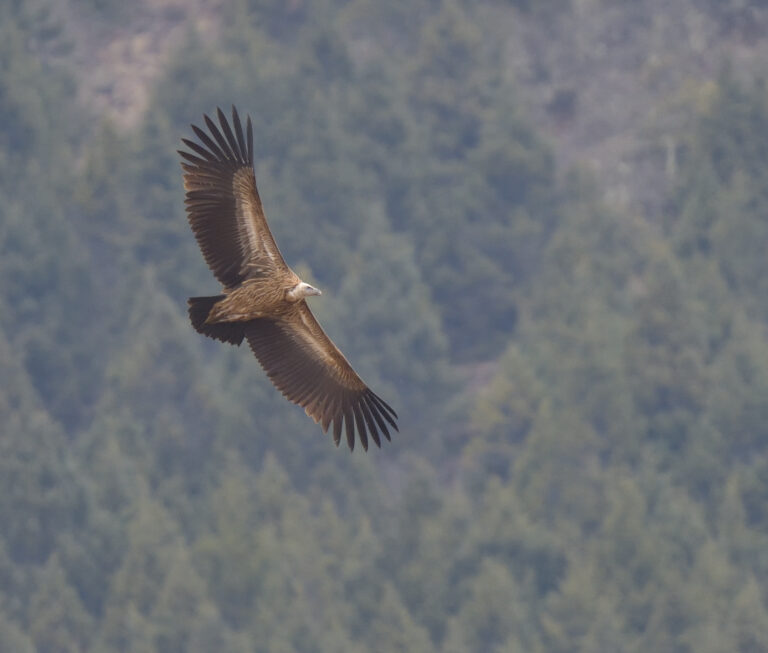
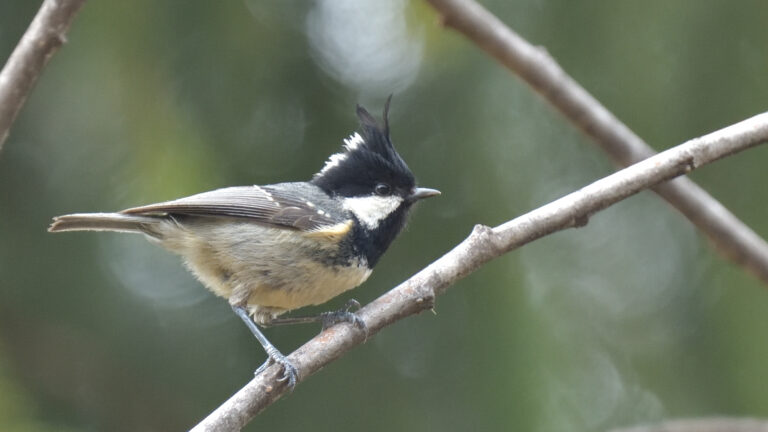
We set off at 4.30am this morning on a slow drive to the Tharpaling Monastery as none of the roads in Bhutan are straight. The reason for the early start is to get to the monastery in time to find early rising birds, and especially the Himalayan Monal. At the start of the rough track leading up to the monastery, at 5.30am, Lynne spots two Wild Boar a couple of hundred yards away by a stony riverbed. Further up the track we spot Blood Pheasant and an impressive male Monal along with several females, all together at the roadside, as if waiting for a bus. It’s about 6.45am by the time we reach the monastery where we accumulate an impressive bird list for a human settlement, including Red-billed Chough, Rufous-breasted and Alpine Accentors, Blue-fronted Redstart, Russet Sparrow, White-browed Rosefinch, White-winged Grosbeak, White-collared Blackbird with an alarm call just like a Ring Ouzel, a flock of about 100 Snow Pigeons, and our target Himalayan Monal, although the views are disappointing in the mist. We also find Moupin Pika here which is a small relative of rabbits and hares.
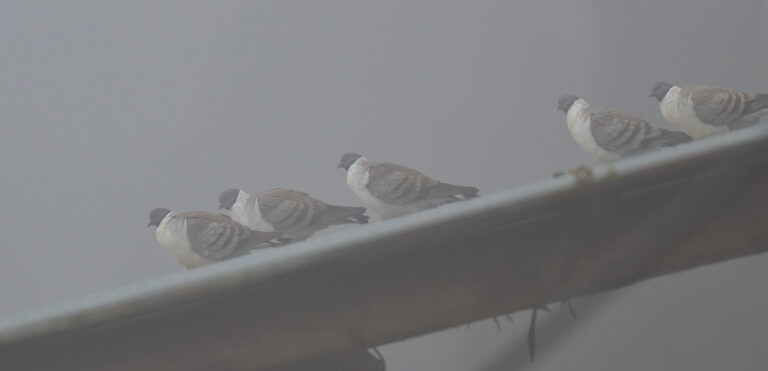
On the way back down the rough monastery track, we find another male Himalayan Monal, lurking deep in the forest and looking resplendent with his glossy rainbow-coloured finery, topped off with a crest of spoon-shaped feathers, especially while displaying with a fanned tail and shaking wings.
After a later than normal picnic breakfast, at the side of the track in lovely warm sunshine, we have another ‘lizard basking’ session before moving on along the PNH-1 road towards Yotongla through yet more beautiful coniferous forest, where a Northern Goshawk is new for the trip. Further on, our next new bird is a Wren, although looking darker and less rufous than ours back home. Meanwhile, on the opposite side of the road, we go from the sublime to the ridiculous with an exotic mixed flock comprising birds like White-tailed Nuthatch, Green-tailed Sunbird, Red-vented and Stripe-throated Yuhinas, White-browed Fulvetta, Ashy-throated Warbler, Green Shrike Babbler, Rufous-fronted Bushtit and Yellow-browed Tit, not seen since day two. Moving on again, we find Bar-throated Minlas and a Bhutan Laughingthrush, which poses very nicely while singing. By late afternoon, the road takes us along the Nikachu River where we find the substantial Crested Kingfisher. By the time we reach the top of the Pelela Pass at 11220 feet, it is too murky to see anything other than a Himalayan Buzzard perched on a nearby treetop. Journey’s end is Gangtey village in the Phobjekha Valley at around 9800 feet, where last sighting of the day is a female Hen Harrier sitting in the wide open valley below the road.
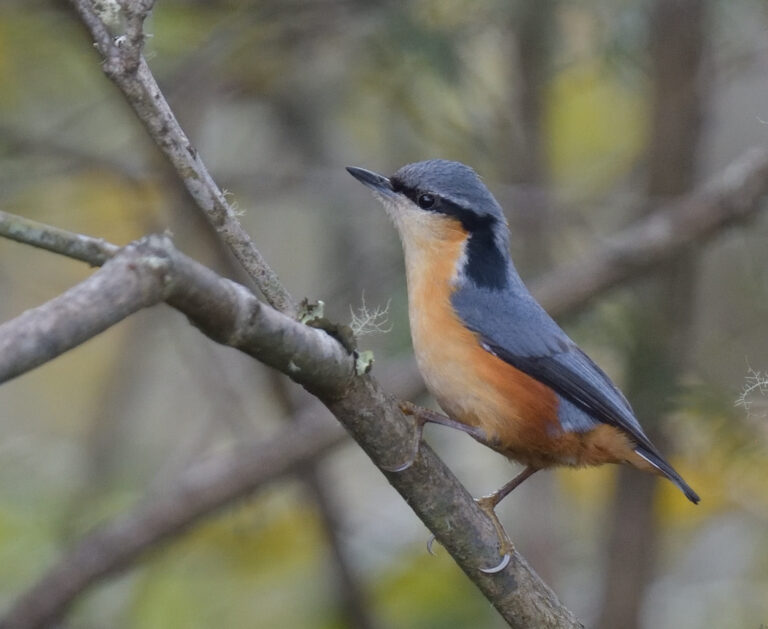
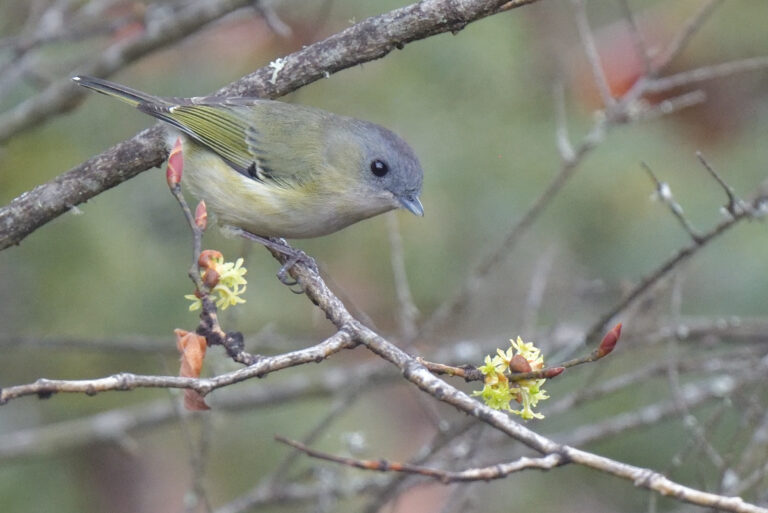
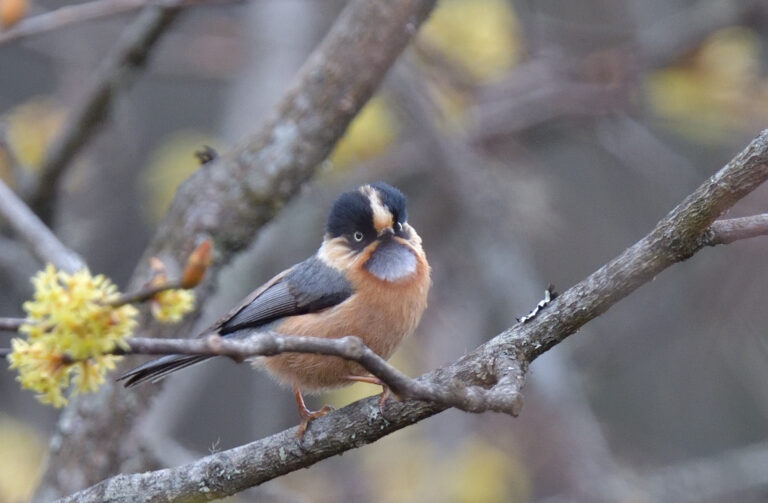
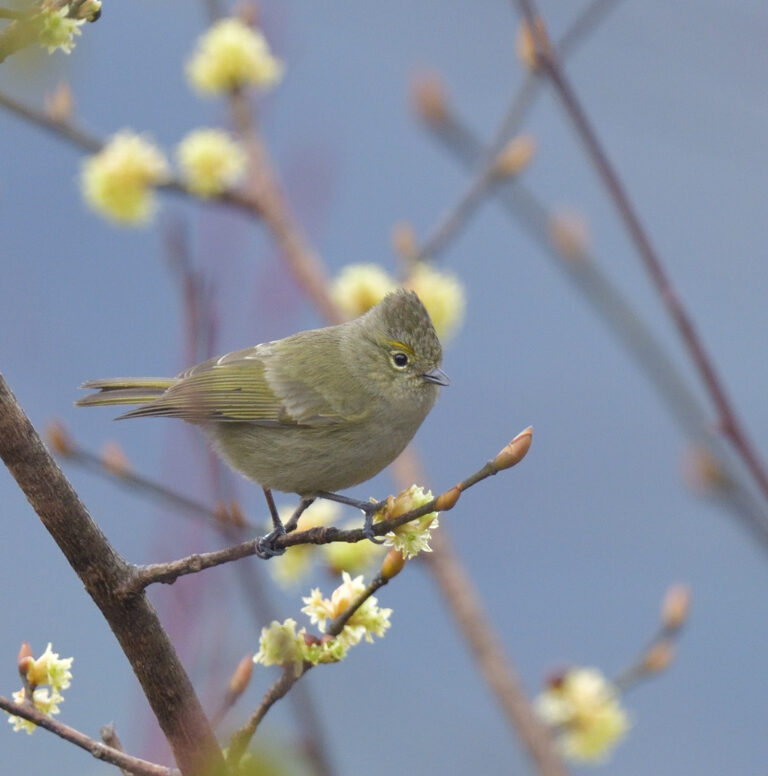
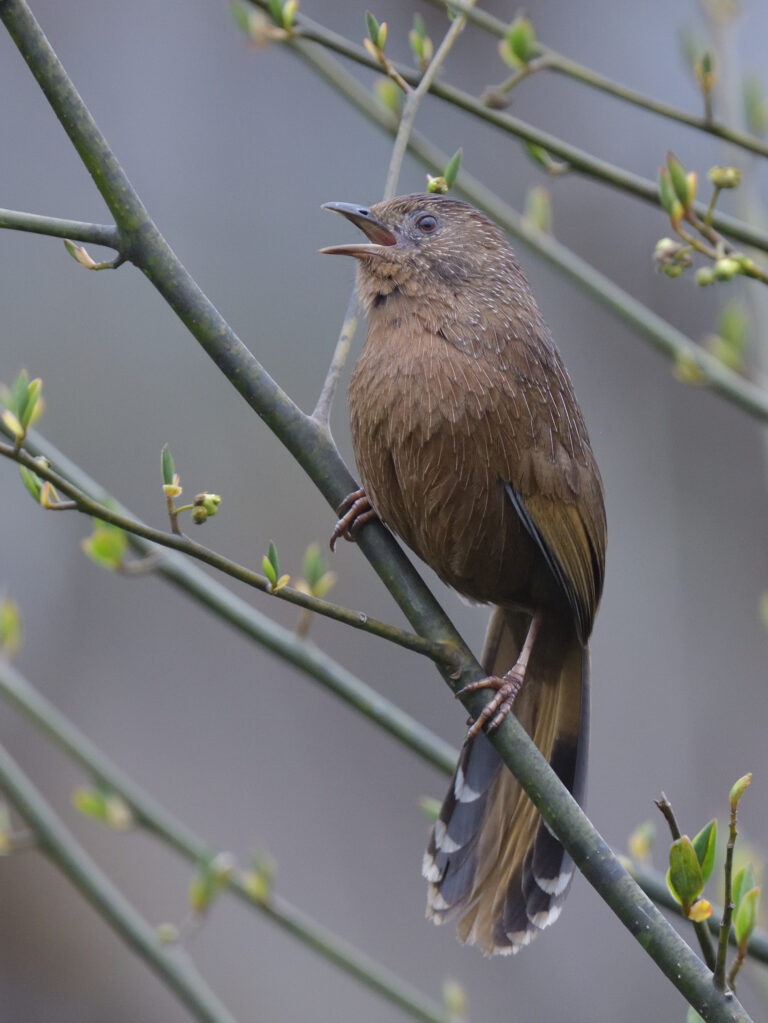
After breakfast at 5am, we return to the Pelela Pass to explore the old, abandoned road that drops down from the top through a nice forest of rhododendrons and conifers, with long drop vistas across the valley to the distant mountains. The slopes here are grazed by magnificent looking Yaks, and along the way we see several Spotted Nutcrackers and Black-faced Laughingthrushes and a Himalayan Vulture, still on its roosting perch. Next, we hear two Satyr Tragopans calling from opposite sides of the track. If anyone can find us a Tragopan, Norbu can! After a patient search, he points down the slope, and there it is, a majestic, white spotted red pheasant, with bare blue facial skin, slowly strutting through the rhododendrons, what a bird! A little later, the neighbouring male flies across the track and down the slope, as if to confront his rival, but in private. Moving on, we spot a pair of Crimson-browed Finches, a pair of Red-gorgeted Flycatchers and a pair of Red-headed Bullfinches. It’s now time for our morning tea break, again under a blue sky, with a Northern Goshawk circling above us. Next, we find a pair of White-browed Rosefinches before rejoining the PNH-1 road back to Thimphu. As the road descends into an evergreen broadleaved forest, we find birds like Hoopoe, Green-backed Tit, Chestnut-crowned Warbler and Himalayan Cutia, and at a cliff face with several large honeycombs hanging from overhanging rocks, we find a Yellow-rumped Honeyguide, keeping a watchful eye on its larder produced by thousands of bees. By now, we are following the Drangchu River, where the last stop before lunch in a posh restaurant in Punakha, produces a Himalayan Prinia which is a small bird with a very long tail.
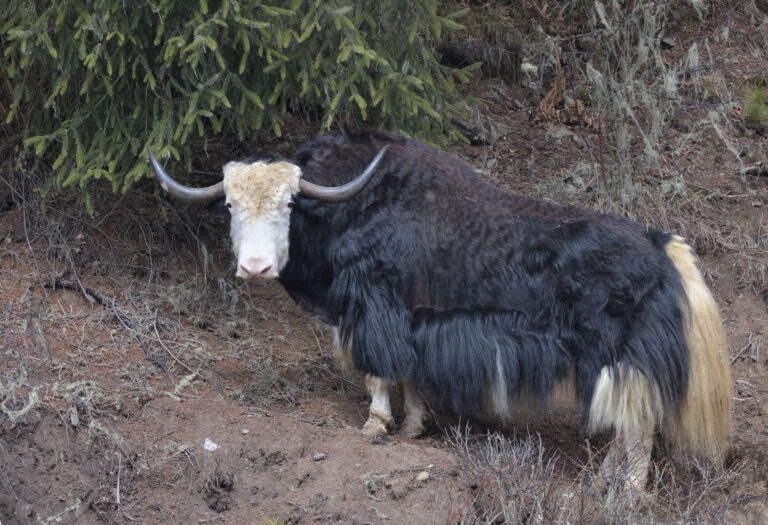
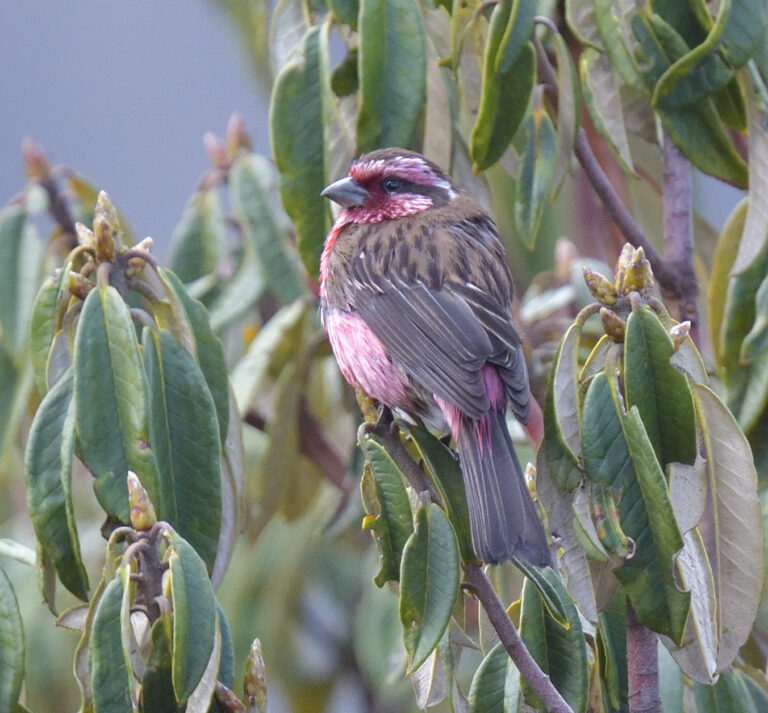
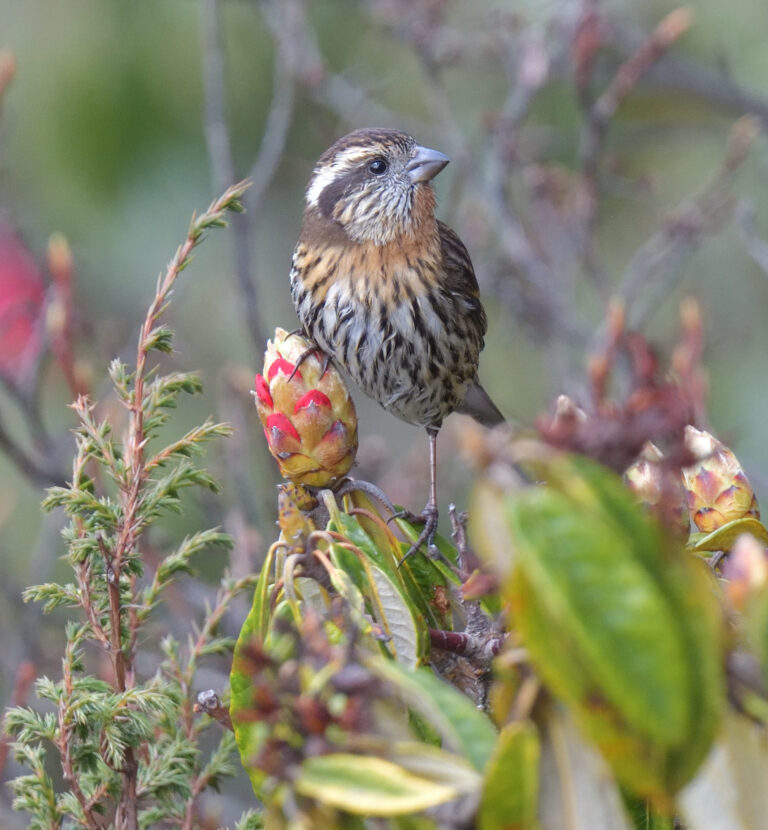
This afternoon, we cross the Dochula Pass, where we started our birding on the first day, and this time we find a flock of Fire-tailed Myzornises, before driving directly to Thimphu, to visit the Royal Takin Preserve, which is actually a small zoo with a collection of native animals including the strange but impressive Takin, which is a large goat-like creature, and Bhutan’s national animal. Within the preserve, we also see Yellow-billed Blue Magpie, Chestnut-crowned Laughingthrush and Plain Mountain Finch which is new for the trip. At the end of a long day, we are back in Paro and check in to the Hotel Olathang, which is the oldest hotel in Bhutan, opened in 1974!
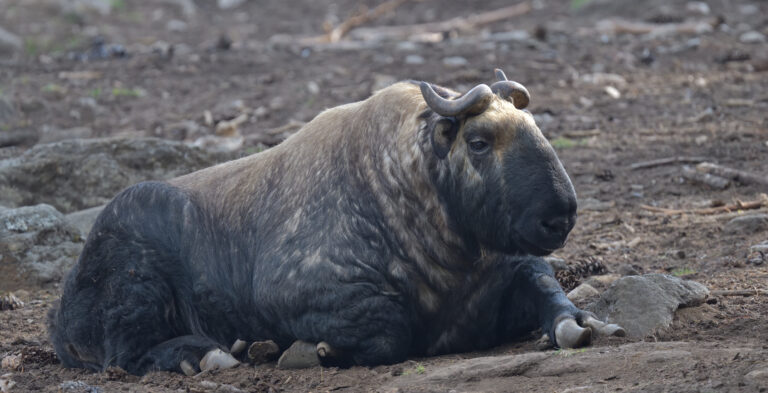
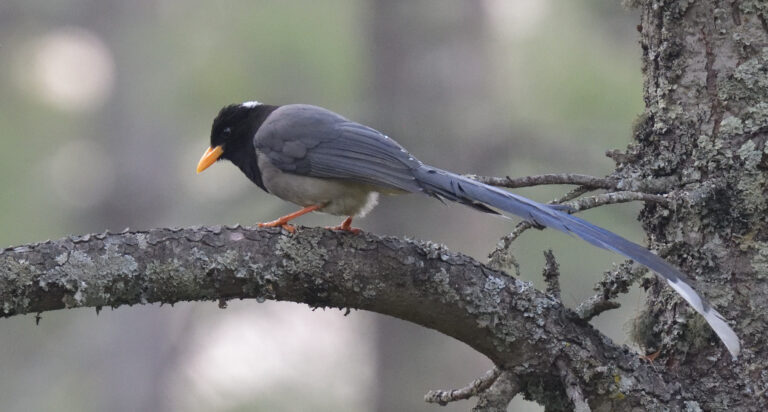
It’s April Fool’s Day, but Tshering isn’t joking about leaving at 5am! The plan is to follow the narrow, winding road through another beautiful coniferous forest up to the Chelela Pass, which is the highest drivable road in Bhutan at an altitude of 12762 feet, with magnificent views of the snow-covered mountains which border Tibet, including Jomolhari, the second highest mountain in Bhutan at almost 24000 feet! With an early start, we hope to find shy birds like Blood Pheasant and Himalayan Monal before they retire into the forest, and we are not disappointed, as we find groups of both these exotic pheasants and even see the spectacular rainbow-coloured male Himalayan Monal on the ground and in flight! Other top birds in this high forest include Collared Grosbeak, Spotted Nutcracker, Grey-crested Tit, a male Mrs Gould’s Sunbird with a glistening amethyst head, and Spotted Laughingthrush, which is one of the smartest looking of all the laughingthrushes. Scanning the cliffs above the forest, we also find a flock of about 100 Snow Pigeons resting on the ledges. Lower down, we end the morning with Olive-backed Pipit, Chestnut-crowned Laughingthrush and Brown Parrotbill.
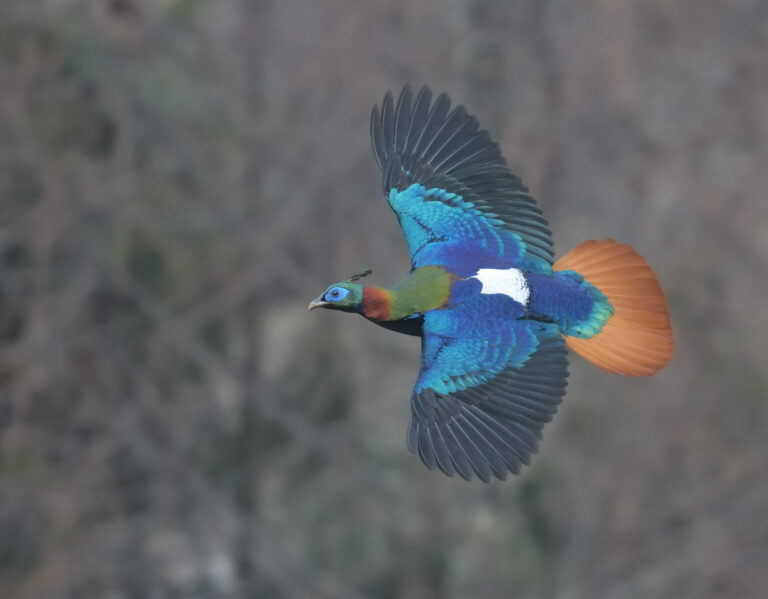
This afternoon, we have lunch in Paro, with free time to explore the town, with all its ornately painted wooden buildings and large colourful prayer wheel in the town centre.
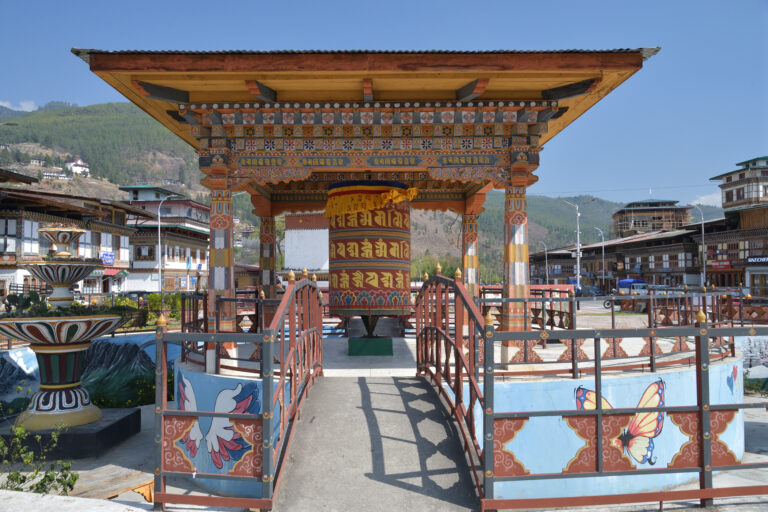
It’s our last full day in this remarkable kingdom and we have a visit to the incredible Tiger’s Nest temple, the tenth holiest site in the Buddhist world and the most iconic site in Bhutan. It’s a beautiful sunny day for it, which is how it should have been every day, according to our guides. With a total climb from the valley floor of about 2300 feet in just 2.8 miles, going almost halfway on horseback is a no brainer, even for Ron who had never sat on a horse before! After dismounting our steeds just below a café, we enjoy a nice cup of tea on the café terrace, in the sunshine with the awesome view of the temple implausibly stuck to a near vertical rock face high above the valley, at an altitude of 10240 feet above sea level. During the tea break, we also enjoy views of the stunning male Mrs Gould’s Sunbird, visiting bright red blooms on a nearby rhododendron tree. It’s now time to complete this breathtaking trek on foot, with around 700 steps to climb, and also descend into a gorge, before the final ascent to the temple complex, with four exquisitely decorated temples, but well worth the effort. Around four hours later, back on the valley floor, looking back to the temple site, it seems incredible to think we were actually up there!
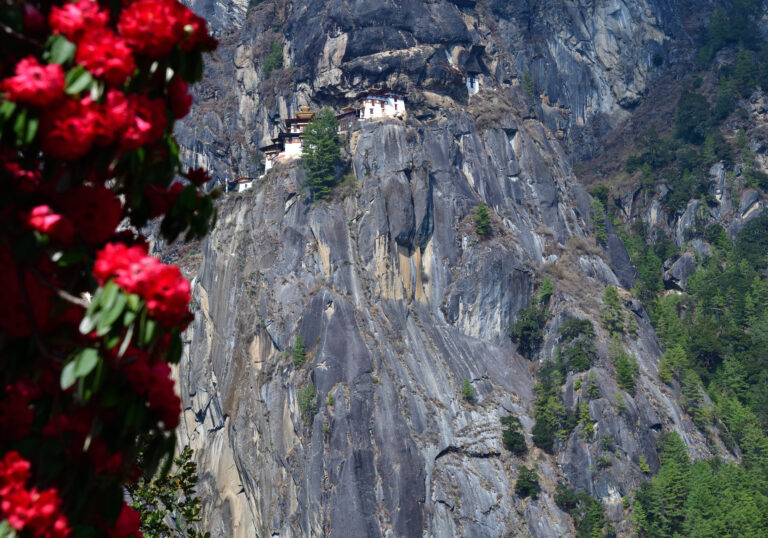
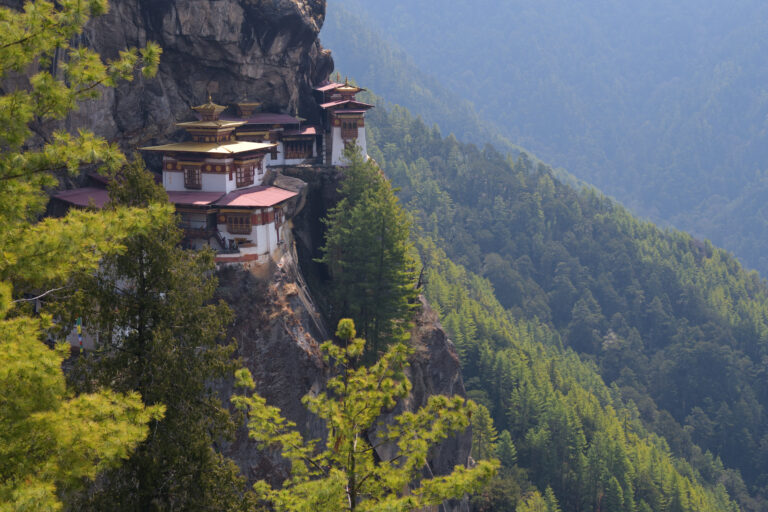
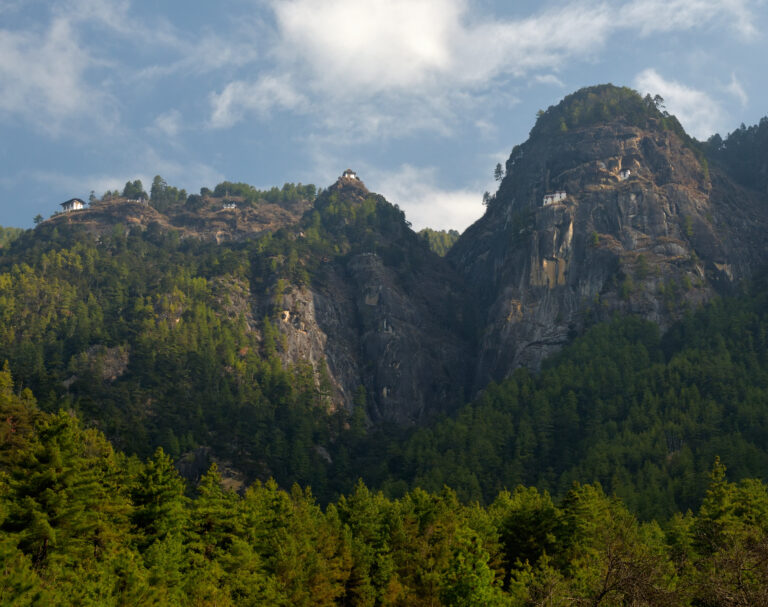
By now we had seen almost 300 different birds including two trogons, three forktails, four hornbills, five barbets, five yuhinas, eight woodpeckers, nine tits, all nine bulbuls and ten laughingthrushes, plus stars like Ibisbill, Tawny Fish Owl, Yellow-rumped Honeyguide, Long-tailed Broadbill, Red-faced Liocichla, Spotted Elachura, Beautiful Nuthatch, the stunning Blood Pheasant, Satyr Tragopan and Himalayan Monal and the mega-rare White-bellied Heron! All this amid wonderful scenery while accompanied by some of the nicest people on earth!
